Sony Group DCRTRV950 Digital Video Camera Recorder TRV950 User Manual manual1
Sony Corporation Digital Video Camera Recorder TRV950 manual1
Contents
manual1
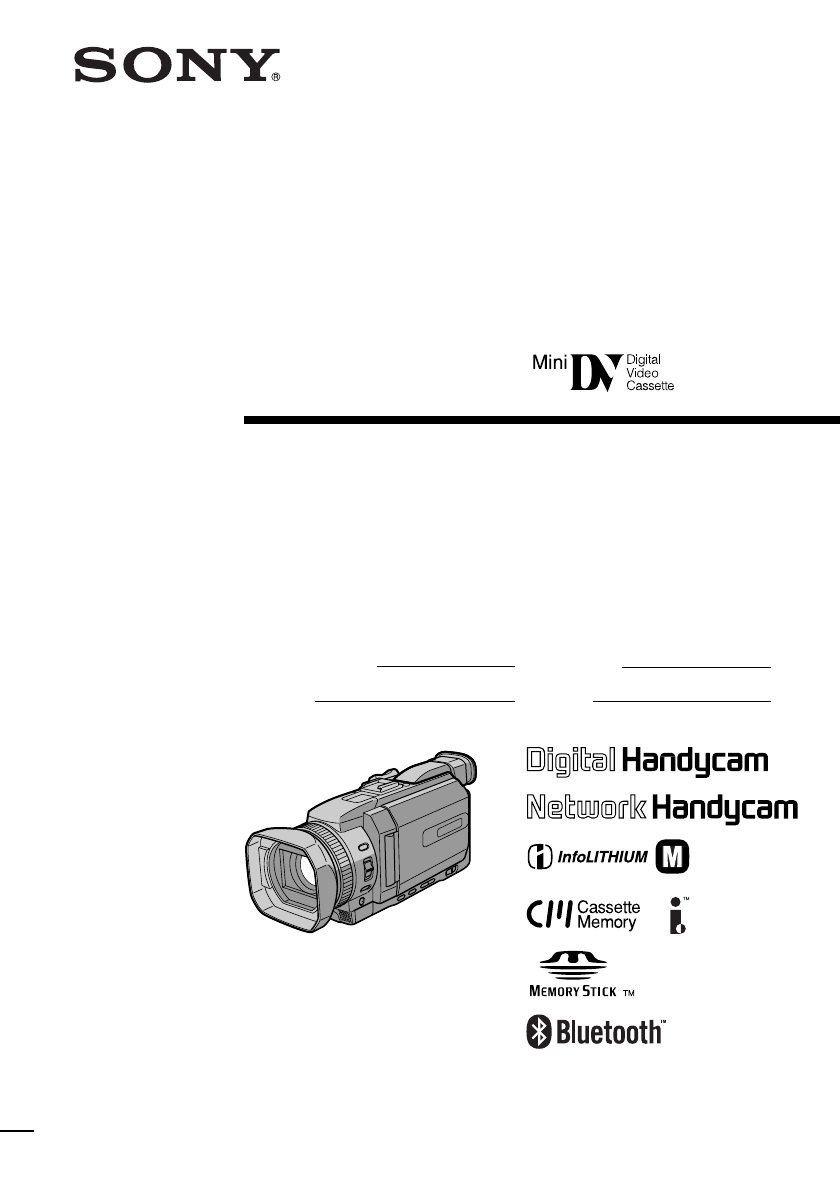
3-075-494-11 (1)
©2002 Sony Corporation
Operating Instructions
Before operating the unit, please read this manual thoroughly,
and retain it for future reference.
Owner’s Record
The model and serial numbers are located on the bottom. Record the
serial number in the space provided below. Refer to these numbers
whenever you call upon your Sony dealer regarding this product.
DCR-TRV940/TRV950
Digital
Video Camera
Recorder
Model No. DCR-TRV Model No. AC-
Serial No. Serial No.
SERIES
TM
DCR-TRV950
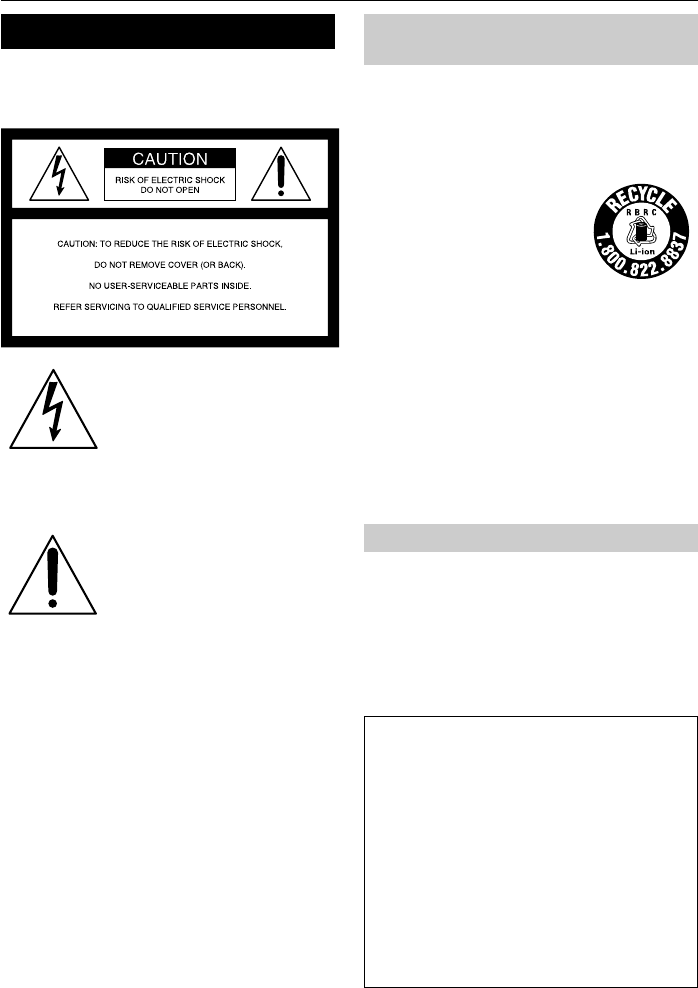
2
Welcome!
Congratulations on your purchase of this Sony Handycam. With your Handycam, you can
capture life’s precious moments with superior picture and sound quality. Your Handycam is
loaded with advanced features, but at the same time it is very easy to use. You will soon be
producing home video that you can enjoy for years to come.
WARNING
To prevent fire or shock hazard, do
not expose the unit to rain or
moisture.
CAUTION
The use of optical instruments with this
product will increase eye hazard. As the laser
beam used in this Handycam is harmful to
eyes, do not attempt to disassemble the
cabinet.
Refer to servicing to qualified personnel only.
NOTICE
If static electricity or electromagnetism causes
data transfer to discontinue midway (fail),
restart the application or disconnect and
connect the USB cable again.
This symbol is intended to
alert the user to the presence
of uninsulated “dangerous
voltage” within the product’s
enclosure that may be of
sufficient magnitude to
constitute a risk of electric
shock to persons.
This symbol is intended to
alert the user to the presence
of important operating and
maintenance (servicing)
instructions in the literature
accompanying the appliance.
For customers in the U.S.A.
and CANADA
CAUTION
TO PREVENT ELECTRIC SHOCK, MATCH
WIDE BLADE OF PLUG TO WIDE SLOT,
FULLY INSERT.
RECYCLING LITHIUM-ION BATTERIES
Lithium-Ion batteries are
recyclable.
You can help preserve our
environment by returning
your used rechargeable
batteries to the collection and
recycling location nearest you.
For more information regarding recycling of
rechargeable batteries, call toll free 1-800-822-
8837, or visit http://www.rbrc.org/.
Caution: Do not handle damaged or leaking
Lithium-Ion batteries.
DCR-TRV950 only
Countries and areas where you can use
network functions are restricted.
For details, refer to the separate Network
Operating Instructions.
For customers in the U.S.A.
If you have any questions about this product,
you may call:
Sony Customer Information Center 1-800-222-
SONY (7669)
The number below is for the FCC related
matters only.
Regulatory Information
Declaration of Conformity
Trade Name: SONY
Model No.: DCR-TRV950
Responsible Party: Sony Electronics Inc.
Address: 680 Kinderkamack
Road, Oradell,
NJ07649 U.S.A.
Telephone No.: 201-930-6972
This device complies with Part 15 of the
FCC Rules. Operation is subject to the
following two conditions: (1) This device
may not cause harmful interference, and
(2)this device must accept any interference
received, including interference that may
cause undesired operation.

3
“Memory Stick”
This device complies with Part 15 of the FCC
Rules. Operation is subject to the following
two conditions: (1) This device may not cause
harmful interference, and (2) this device must
accept any interference received, including
interference that may cause undesired
operation.
CAUTION
You are cautioned that any changes or
modifications not expressly approved in this
manual could void your authority to operate
this equipment.
DCR-TRV950 only
IMPORTANT NOTE
To comply with FCC RF exposure compliance
requirements, the following antenna
installation and device operating
configurations must be satisfied: the antenna
has been installed by the manufacturer and no
changes can be made.
Note:
This equipment has been tested and found to
comply with the limits for a Class B digital
device, pursuant to Part 15 of the FCC Rules.
These limits are designed to provide
reasonable protection against harmful
interference in a residential installation. This
equipment generates, uses, and can radiate
radio frequency energy and, if not installed
and used in accordance with the instructions,
may cause harmful interference to radio
communications. However, there is no
guarantee that interference will not occur in a
particular installation. If this equipment does
cause harmful interference to radio or
television reception, which can be determined
by turning the equipment off and on, the user
is encouraged to try to correct the interference
by one or more of the following measures:
—Reorient or relocate the receiving antenna.
—Increase the separation between the
equipment and receiver.
—Connect the equipment into an outlet on a
circuit different from that to which the
receiver is connected.
—Consult the dealer or an experienced
radio/TV technician for help.
For customers in CANADA
“Memory Stick”
This Class B digital apparatus complies with
Canadian ICES-003.
DCR-TRV950 only
The term “IC:” before the radio certification
number only signifies that Industry Canada
technical specifications were met.
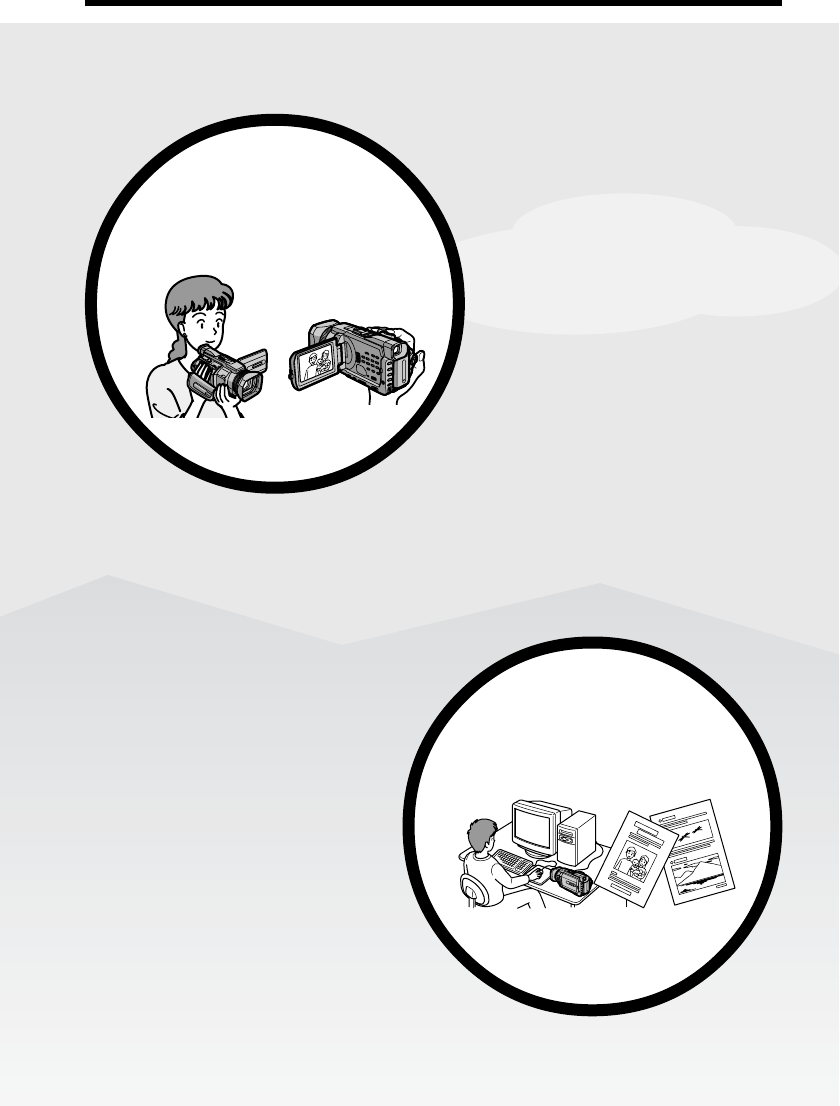
4
Recording moving pictures
or still images, and playing
them back
•Recording moving pictures on a
tape (p. 26)
•Recording still images on a tape
(p. 51)
•Playing back a tape (p. 39)
•Recording still images on a
“Memory Stick” (p. 46, 135)
•Recording moving pictures on a
“Memory Stick” (p. 153)
•Viewing still images recorded on a
“Memory Stick” (p. 165)
•Viewing moving pictures on a
“Memory Stick” (p. 168)
Capturing images on your
computer
•Viewing images recorded on a
“Memory Stick” using the USB cable
(p. 199, 203)
•Viewing moving pictures recorded on
tapes using the USB cable (p. 194)
•Capturing images on your computer
from your camcorder using the USB
cable (p. 196)
•Converting an analog signal to
digital to capture images onto your
computer (p. 204)
4
Main Features
Main Features
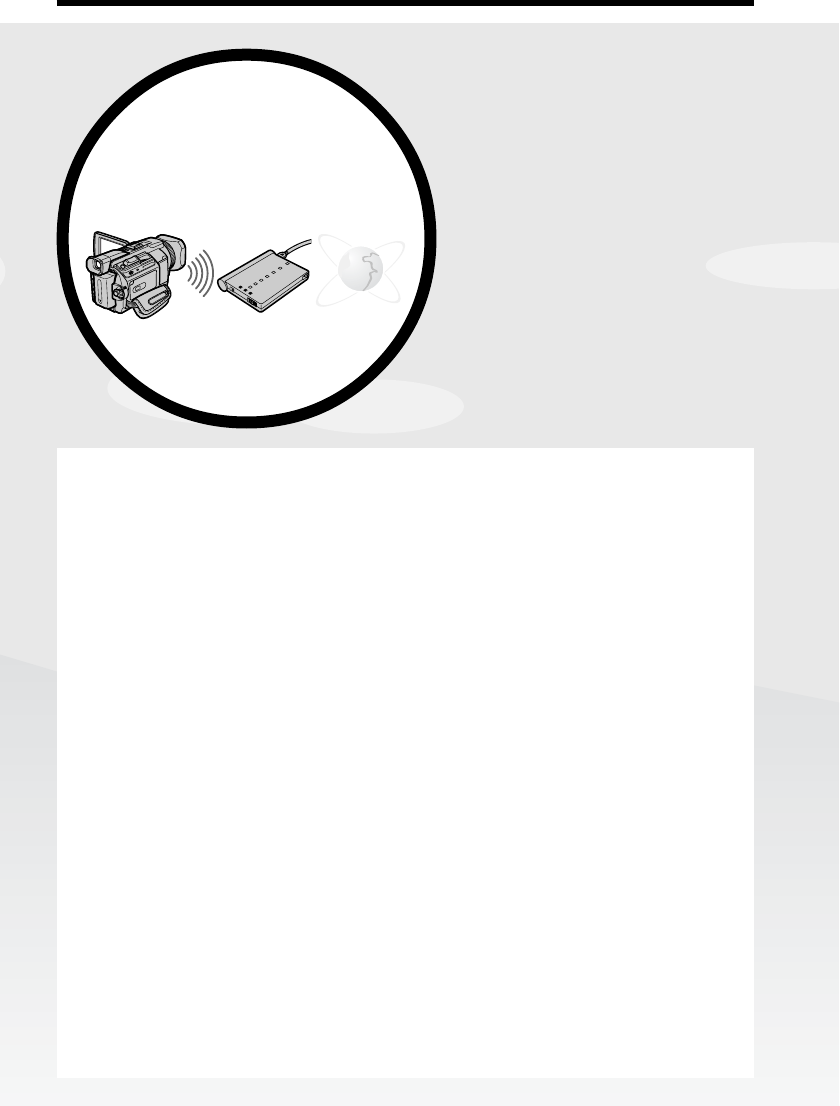
Getting Started
5
Main Features
Accessing the Internet, sending/
receiving your e-mail. For details,
refer to the Network Function
Operating Instructions supplied
with your camcorder. (DCR-
TRV950 only) (p. 205)
5
Other uses
Functions for adjusting the exposure in the recording mode
•BACK LIGHT (p. 34)
•SPOT LIGHT (p. 35)
•Recording images with the flash (p. 48, 139)
•PROGRAM AE (p. 67)
•Adjusting the exposure manually (p. 74)
•Flexible Spot Meter (p. 75)
Functions for giving images more impact
•Digital zoom (p. 31)
The default setting is OFF. (To zoom greater than 12×, select the digital zoom power in
D ZOOM in the menu settings.)
•Fader (p. 55)
•Picture effect (p. 58)
•Digital effect (p. 59)
•Titles (p. 119)
•MEMORY MIX (p. 148)
Functions for giving a natural appearance to your recordings
•Sports lesson (p. 67)
•Landscape (p. 67)
•Manual focus (p. 76)
•Spot Focus (p. 78)
Functions for use with recorded tapes
•END SEARCH/EDITSEARCH/Rec Review (p. 37)
•DATA CODE (p. 41)
•Tape PB ZOOM (p. 86)
•ZERO SET MEMORY (p. 88)
•TITLE SEARCH (p. 89)
•Digital program editing (p. 98, 160)
Accessing the Internet via a
Bluetooth compliant device
(DCR-TRV950 only)
Main Features

6
Table of contents
Main Features....................................... 4
Quick Start Guide
– Recording on a tape ............................ 8
– Recording on a “Memory Stick” ..... 10
Getting Started
Using this manual ................................. 12
Checking supplied accessories............ 14
Step 1 Preparing the power supply ... 15
Installing the battery pack............. 15
Charging the battery pack............. 16
Connecting to a wall outlet ........... 19
Step 2 Setting the date and time ........ 20
Step 3 Inserting a cassette ................... 23
Step 4 Using the touch panel .............. 24
Recording – Basics
Recording a picture............................... 26
Shooting backlit subjects
– BACK LIGHT ........................ 34
Shooting subjects lit by strong light
– SPOT LIGHT ......................... 35
Self-timer recording ....................... 36
Checking recordings
– END SEARCH /
EDITSEARCH / Rec Review ........ 37
Playback – Basics
Playing back a tape ............................... 39
To display the screen indicators
– Display function ................... 41
Viewing the recording on TV .............. 45
Advanced Recording
Operations
Recording still images on a “Memory
Stick” during tape recording ........ 46
Recording still images on a tape
– Tape Photo recording ................. 51
Using the wide mode ........................... 53
Using the fader ...................................... 55
Using special effects
– Picture effect................................. 58
Using special effects
– Digital effect ................................. 59
Presetting the adjustment for picture
quality
– Custom preset .............................. 62
Using the guide frame .......................... 64
Shooting with the zebra pattern ......... 65
Using the color bar................................ 66
Shooting with manual adjustment ..... 67
Using the PROGRAM AE ............. 67
Adjusting the shutter speed .......... 70
Adjusting the white balance ......... 72
Adjusting the exposure ................. 74
Using the spot light-metering
– Flexible Spot Meter ............... 75
Focusing manually................................ 76
Using the spot focus – Spot Focus ...... 78
Adjusting recording level manually
– Sound recording level ................. 79
Interval recording ................................. 81
Frame by frame recording
– Frame recording .......................... 83
Advanced Playback
Operations
Playing back tapes with picture
effect ................................................. 84
Playing back tapes with digital
effect ................................................. 85
Enlarging images recorded on tapes
– Tape PB ZOOM ........................... 86
Quickly locating a scene
– ZERO SET MEMORY ................. 88
Searching the boundaries of a recorded
tape by title – TITLE SEARCH ..... 89
Searching a recording by date
– DATE SEARCH ........................... 90
Searching for a photo – PHOTO
SEARCH/PHOTO SCAN ............. 92
Editing
Dubbing a tape ...................................... 95
Dubbing only desired scenes
– Digital program editing
(on tapes) ......................................... 98
Recording video or TV programs ..... 109
Inserting a scene from a VCR
– Insert Editing ............................. 113
Audio dubbing .................................... 115
Superimposing a title ......................... 119
Making your own titles ...................... 122
Labeling a cassette .............................. 124

Getting Started
7
Table of contents
“Memory Stick” Operations
Using a “Memory Stick”
– Introduction ............................... 126
Recording still images on a “Memory
Stick”
– Memory Photo recording ......... 135
Recording images from a tape as still
images ............................................ 144
Superimposing a still image in the
“Memory Stick” on an image
– MEMORY MIX .......................... 148
Recording moving pictures on
a“Memory Stick”
– MPEG movie recording ............ 153
Recording pictures from a tape as a
moving picture ............................. 156
Recording edited pictures from a tape as
a moving picture
– Digital program editing
(on a “Memory Stick”) ................. 160
Copying still images from a tape
– PHOTO SAVE ............................ 163
Viewing still images
– Memory photo playback .......... 165
Viewing moving pictures
– MPEG movie playback ............. 168
Copying images recorded on a
“Memory Stick” to a tape ............ 171
Enlarging still images recorded on a
“Memory Stick”
– Memory PB ZOOM ................... 173
Playing back images in a continuous
loop – SLIDE SHOW .................... 175
Preventing accidental erasure
– Image protection........................ 176
Deleting images – DELETE ............... 177
Writing a print mark
– PRINT MARK ............................ 180
Using the optional printer ................. 181
Viewing Images Using your
Computer
Viewing images on your computer
– Introduction ............................... 183
Connecting your camcorder to your
computer using the USB cable
– For Windows users ................... 186
Viewing images recorded on a tape on
your computer
– For Windows users ................... 194
Viewing images recorded on a
“Memory Stick” on your computer
– For Windows users ................... 199
Connecting your camcorder to your
computer using the USB cable
– For Macintosh users .................. 201
Viewing images recorded on a
“Memory Stick” on your computer
– For Macintosh users .................. 203
Capturing images from an analog video
unit on your computer
– Signal convert function............. 204
Using the Network function
(DCR-TRV950 only)
Accessing the network ....................... 205
For the details, refer to the Network
Function Operating Instructions
supplied with your camcorder.
Customizing Your Camcorder
Changing the default settings with the
menu............................................... 207
Troubleshooting
Types of trouble and how to correct
trouble ............................................ 218
Self-diagnosis display......................... 225
Warning indicators and messages .... 226
Additional Information
Usable cassettes ................................... 228
About the “InfoLITHIUM” battery
pack ................................................ 231
About i.LINK ....................................... 233
Using your camcorder abroad .......... 235
Maintenance information and
precautions .................................... 236
Specifications ....................................... 242
Quick Reference
Identifying parts and controls........... 244
Index ..................................................... 254
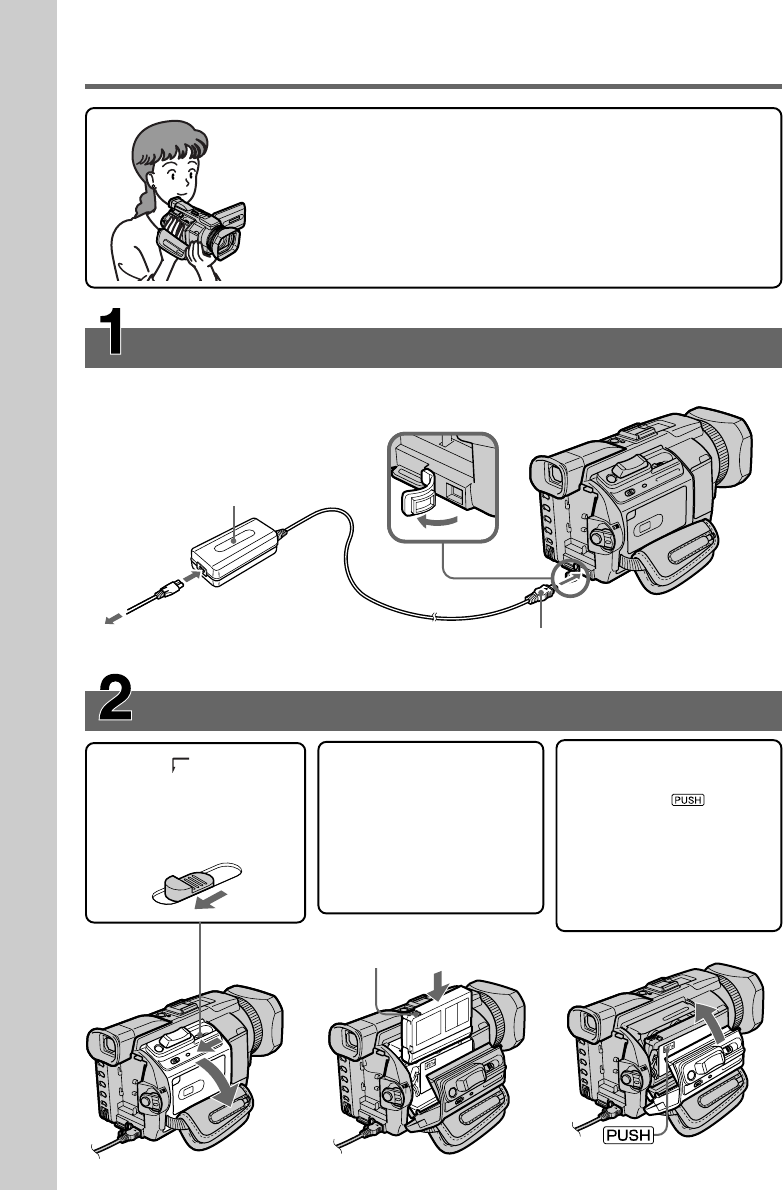
Quick Start Guide
8
Inserting a cassette (p. 23)
Connecting the power cord (p. 19)
Use the battery pack when using your camcorder outdoors (p. 15).
1Slide OPEN/Z
EJECT in the
direction of the
arrow to open the
lid.
2Insert the cassette
straight as far as
possible into the
cassette compartment
with the window
facing out and the
write-protect tab
facing upward.
3Close the cassette
compartment by
pressing on the
cassette compartment.
After the cassette
compartment goes
down completely,
close the lid until it
clicks.
This chapter introduces you to the basic features to recorded
pictures on tapes of your camcorder. See the page in parentheses
“( )” for more information.
AC power adaptor (supplied)
Connect the plug with its v
mark facing up.
Open the DC
IN jack cover.
Write-protect tab
Quick Start Guide – Recording on a tape
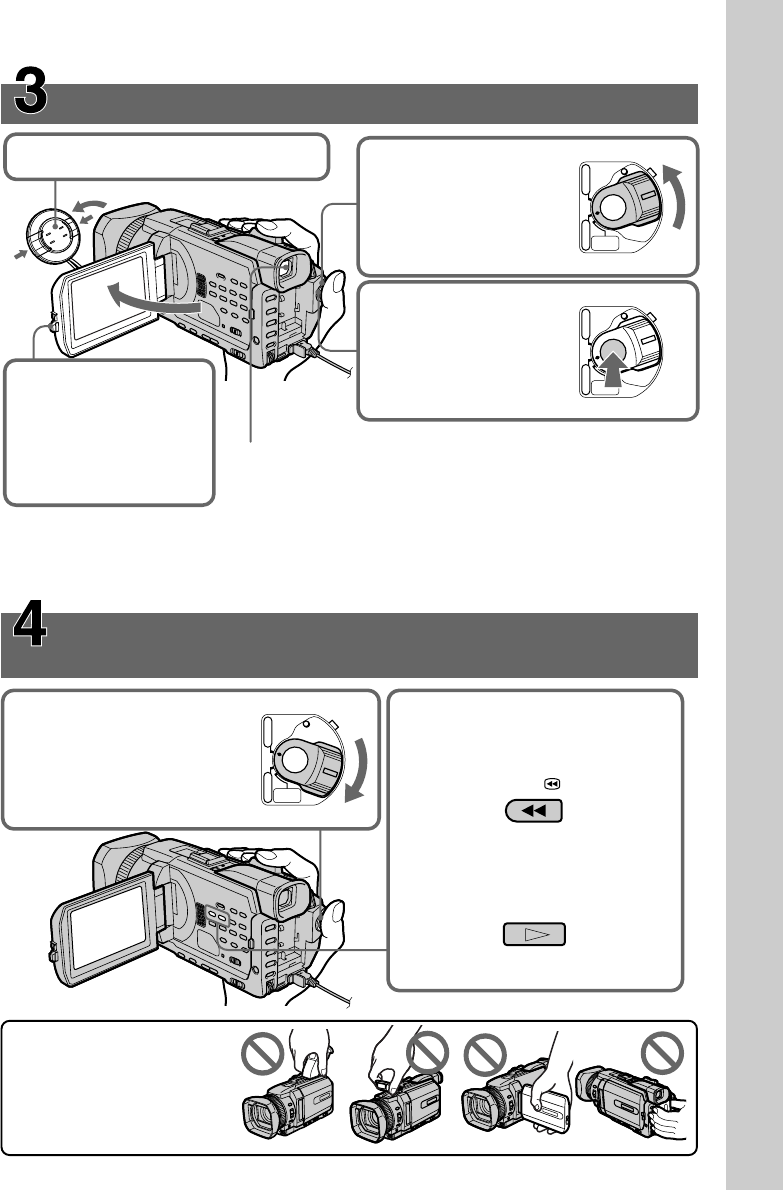
Quick Start Guide
9
REW
PLAY
POWER
OFF(CHG)
CAMERA
MEMORY/
NETWORK
VCR
POWER
OFF(CHG)
CAMERA
MEMORY/
NETWORK
VCR
POWER
OFF(CHG)
CAMERA
MEMORY/
NETWORK
VCR
Recording a picture (p. 26)
1Remove the lens cap.
3Press OPEN to open
the LCD panel.
The picture appears
on the screen.
2Set the POWER
switch to CAMERA
while pressing the
small green button.
4Press START/STOP.
Your camcorder
starts recording. To
stop recording, press
START/STOP again.
Monitoring the playback picture on the LCD
screen (p. 39)
NOTE
Do not pick up your
camcorder by holding the
viewfinder, the flash, the LCD
panel or the battery pack.
When you purchase your camcorder, the clock setting is set to off. If you want to record
the date and time for a picture, set the clock setting before recording (p. 20).
Viewfinder
When the LCD panel is closed, use the viewfinder with your eye
against the eyecup.
Adjust the viewfinder lens to your eyesight (p. 30).
1Set the POWER switch
to VCR while pressing
the small green button.
2Press m to rewind the tape.
3Press N to start playback.
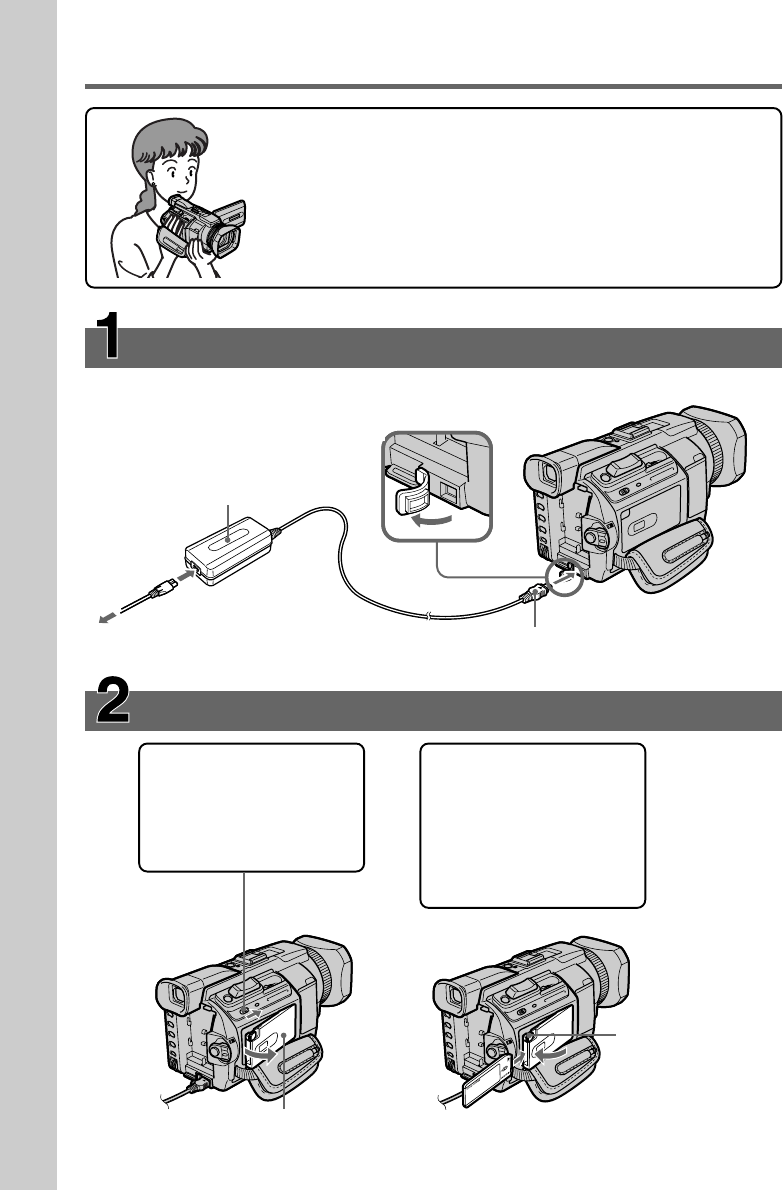
Quick Start Guide
10
This chapter introduces you to the basic features to record on a
“Memory Stick” of your camcorder. See the page in parentheses
“( )” for more information.
Press the MEMORY
EJECT once lightly to
eject it.
Connecting the power cord (p. 19)
Use the battery pack when using your camcorder outdoors (p. 15).
Open the DC IN
jack cover.
Connect the plug with its v
mark facing up.
AC power adaptor (supplied)
1Slide MEMORY
OPEN in the
direction of the arrow
to open the “Memory
Stick” slot.
2Insert a “Memory
Stick” in the
“Memory Stick” slot
as far as it can go
with the B mark
facing up as
illustrated.
“Memory Stick” slot
MEMORY EJECT
Inserting a “Memory Stick” (p. 128)
Quick Start Guide – Recording on a “Memory Stick”
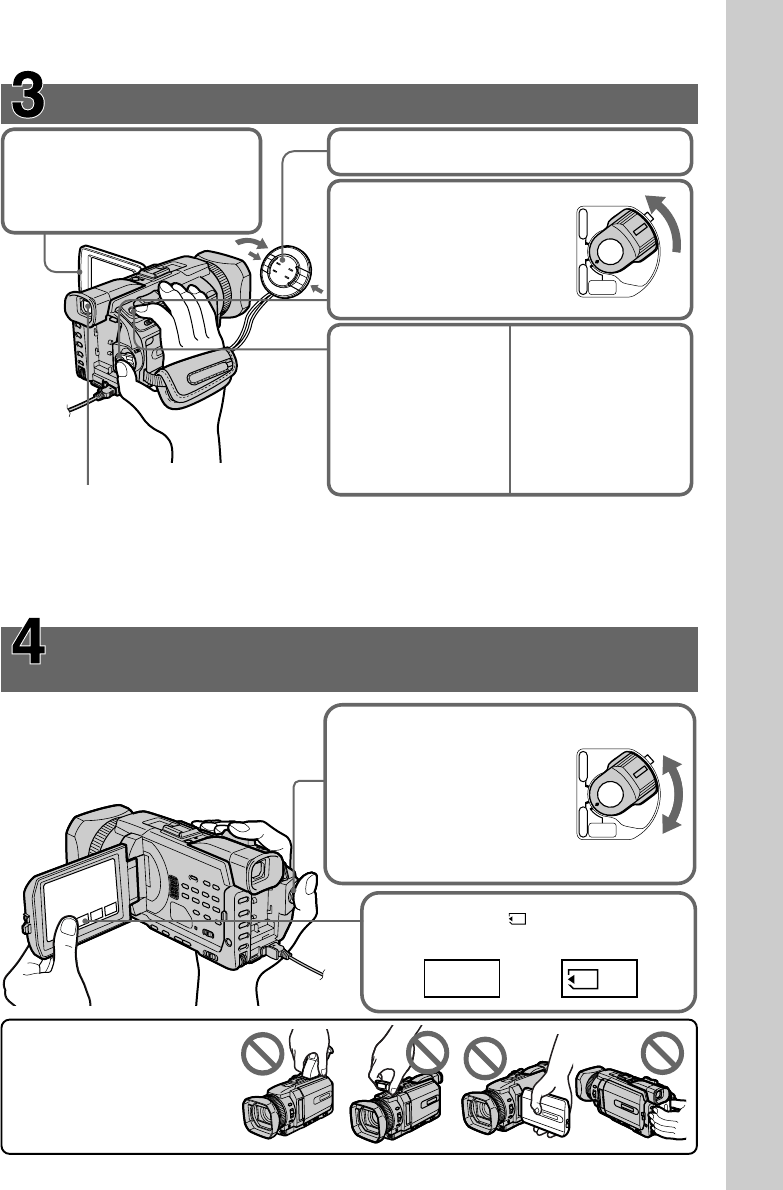
Quick Start Guide
11
PLAY PB
POWER
OFF(CHG)
CAMERA
MEMORY/
NETWORK
VCR
POWER
OFF(CHG)
CAMERA
MEMORY/
NETWORK
VCR
Recording a still image on a “Memory Stick”
(p. 135)
When you purchase your camcorder, the clock setting is set to off. If you want to record
the date and time for a picture, set the clock setting before recording (p. 20).
NOTE
Do not pick up your
camcorder by holding the
viewfinder, the flash, the LCD
panel or the battery pack.
Monitoring the playback still images on the LCD
screen (p. 165)
1Set the POWER switch to
MEMORY/NETWORK
(DCR-TRV950 only)
or VCR while pressing the
small green button.
2Press PLAY or PB. The last recorded
image is displayed.
1Remove the lens cap.
3Press OPEN to open
the LCD panel.
The picture appears on
the screen.
Viewfinder
When the LCD panel is closed, use the viewfinder with your eye
against the eyecup.
Adjust the viewfinder lens to your eyesight (p. 30).
2Set the POWER switch to
MEMORY/NETWORK
(DCR-TRV950 only)
while pressing the small
green button.
4Press PHOTO
lightly.
You can start
recording when the
small green button
on the screen stops
flashing, and lights
up.
5Press PHOTO
deeper.
The image while
pressing the
button deeply is
recorded on the
“Memory Stick.”
or
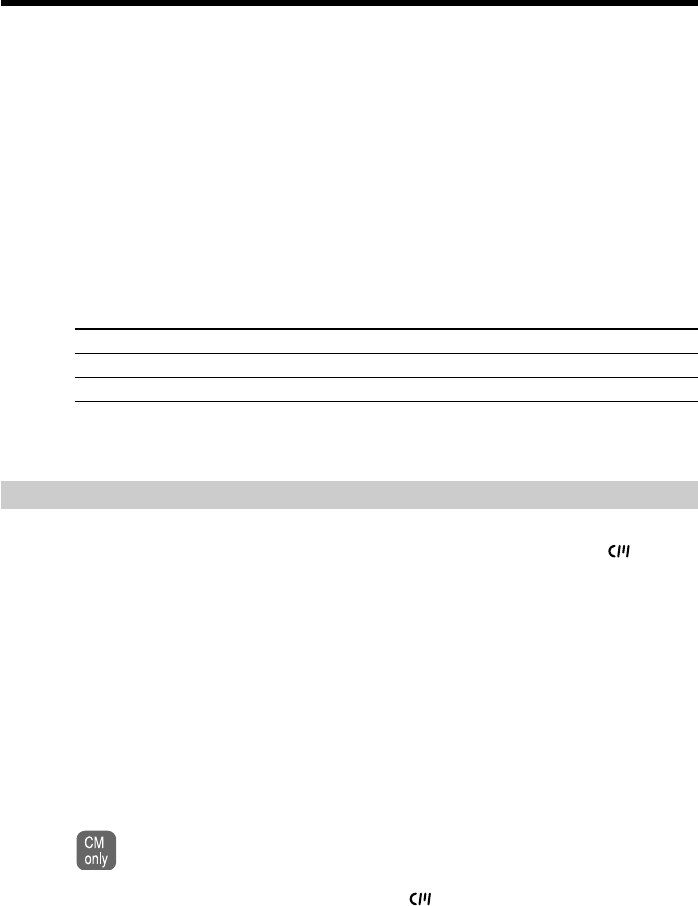
12
— Getting Started —
Using this manual
The instructions in this manual are for the two models listed in the table below. Before
you start reading this manual and operating your camcorder, check the model number
by looking at the bottom of your camcorder. The DCR-TRV950 is the model used for
illustration purposes. Otherwise, the model name is indicated in the illustrations. Any
differences in operation are clearly indicated in the text, for example, “DCR-TRV950
only”.
As you read through this manual, buttons and settings on your camcorder are shown in
capital letters.
e.g. Set the POWER switch to CAMERA.
When you carry out an operation, you can hear a beep to indicate that the operation is
being carried out.
Types of differences
DCR- TRV940 TRV950
Mark on the POWER switch MEMORY MEMORY/NETWORK
Network function — z
zProvided
—Not provided
Note on Cassette Memory
Your camcorder is based on the DV format. You can use only mini DV cassettes with
your camcorder. We recommend that you use a tape with cassette memory .
Functions that require different operations depending on whether or not the tape has a
cassette memory are:
–END SEARCH (p. 37)
–DATE SEARCH (p. 90)
–PHOTO SEARCH (p. 92)
Functions you can operate only with the cassette memory are:
–TITLE SEARCH (p. 89)
–Superimposing a title (p. 119)
–Labeling a cassette (p. 124)
For details of cassette types, see page 228.
You see this mark in the introduction of features that are operated only with
cassette memory.
Cassettes with cassette memory are marked by (Cassette Memory).
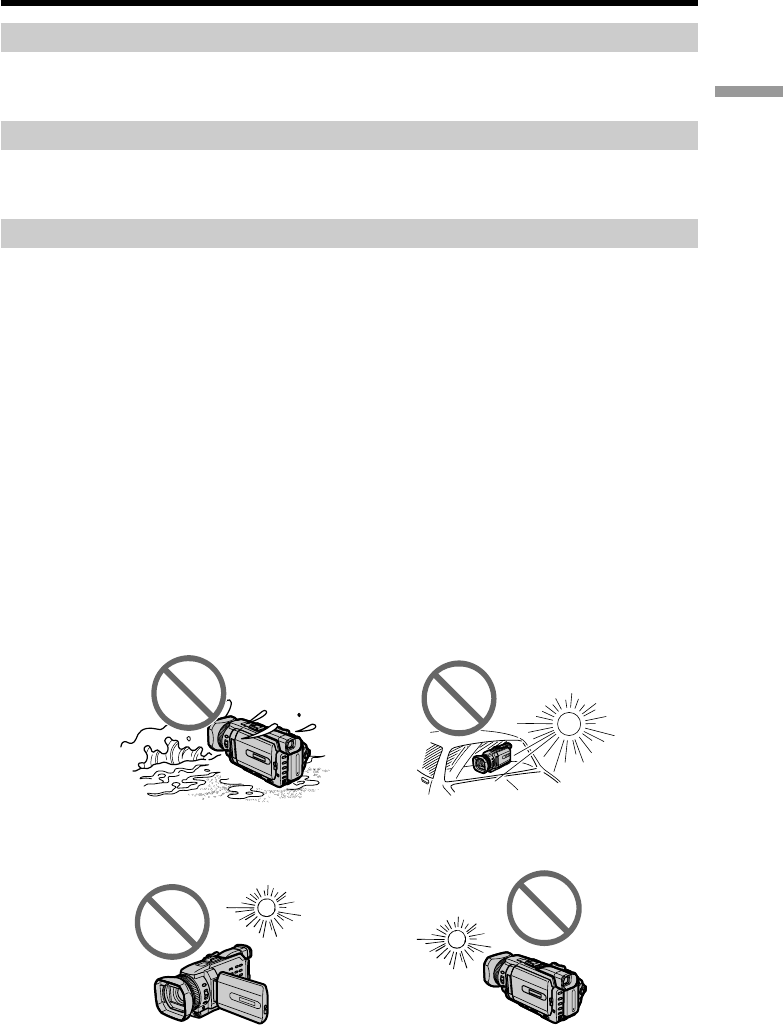
Getting Started
13
Using this manual
Note on TV color systems
TV color systems differ depending on the country or region. To view your recordings
on a TV, you need an NTSC system-based TV.
Copyright precautions
Television programs, films, video tapes, and other materials may be copyrighted.
Unauthorized recording of such materials may be contrary to the copyright laws.
Precautions on camcorder care
Lens and LCD screen/finder (on mounted models only)
•The LCD screen and the finder are manufactured using extremely high-precision
technology, so over 99.99% of the pixels are operational for effective use.
However, there may be some tiny black points and/or bright points (white, red,
blue or green in color) that constantly appear on the LCD screen and the finder.
These points are normal in the manufacturing process and do not affect the
recording in any way.
•Do not let your camcorder get wet. Keep your camcorder away from rain and sea
water. Letting your camcorder get wet may cause your camcorder to malfunction.
Sometimes this malfunction cannot be repaired [a].
•Never leave your camcorder exposed to temperatures above 60°C (140°F), such as in a
car parked in the sun or under direct sunlight [b].
•Be careful when placing the camera near a window or outdoors. Exposing the LCD
screen, the finder or the lens to direct sunlight for long periods may cause
malfunctions [c].
•Do not directly shoot the sun. Doing so might cause your camcorder to malfunction.
Take pictures of the sun in low light conditions such as dusk [d].
[a][b]
[c][d]
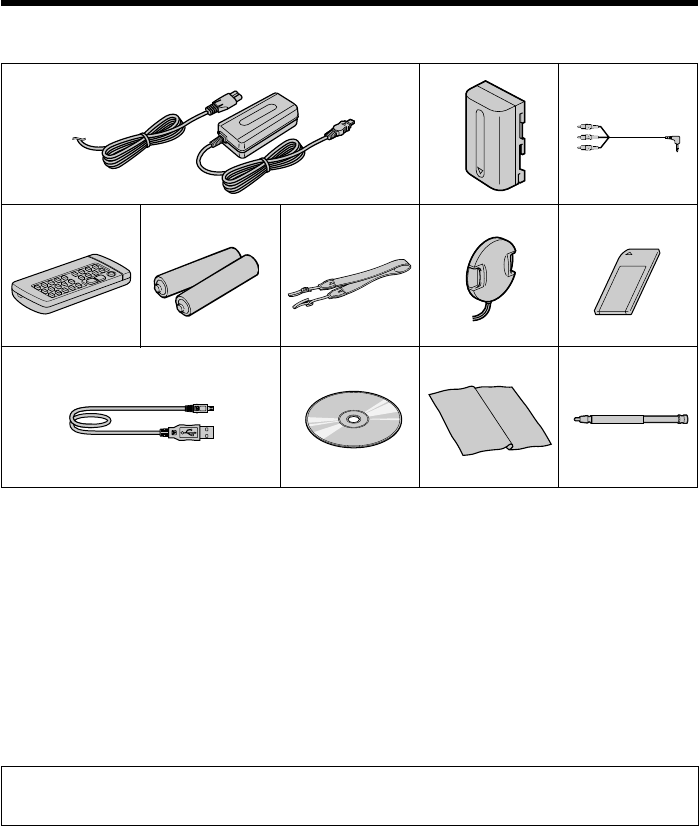
14
Checking supplied accessories
Make sure that the following accessories are supplied with your camcorder.
1AC-L10A/L10B/L10C AC power
adaptor (1), power cord (1) (p. 16)
2NP-FM50 battery pack (1) (p. 15, 16)
3A/V connecting cable (1) (p. 45)
4Wireless Remote Commander (1)
(p. 250)
5Size AA (R6) battery for Remote
Commander (2) (p. 251)
6Shoulder strap (1)
Contents of the recording cannot be compensated if recording or playback is not made due to a
malfunction of the camcorder, storage media, etc.
7Lens cap (1) (p. 26)
8“Memory Stick” (1) (p. 126)
9USB cable (1) (p. 183)
0CD-ROM (SPVD-008 USB Driver) (1)
(p. 188)
qa Cleaning cloth (1) (p. 237)
qs Stylus (1) (DCR-TRV950 only) (p. 206)
9
1
4
q;
5
qa
6
qs
2
7
3
8
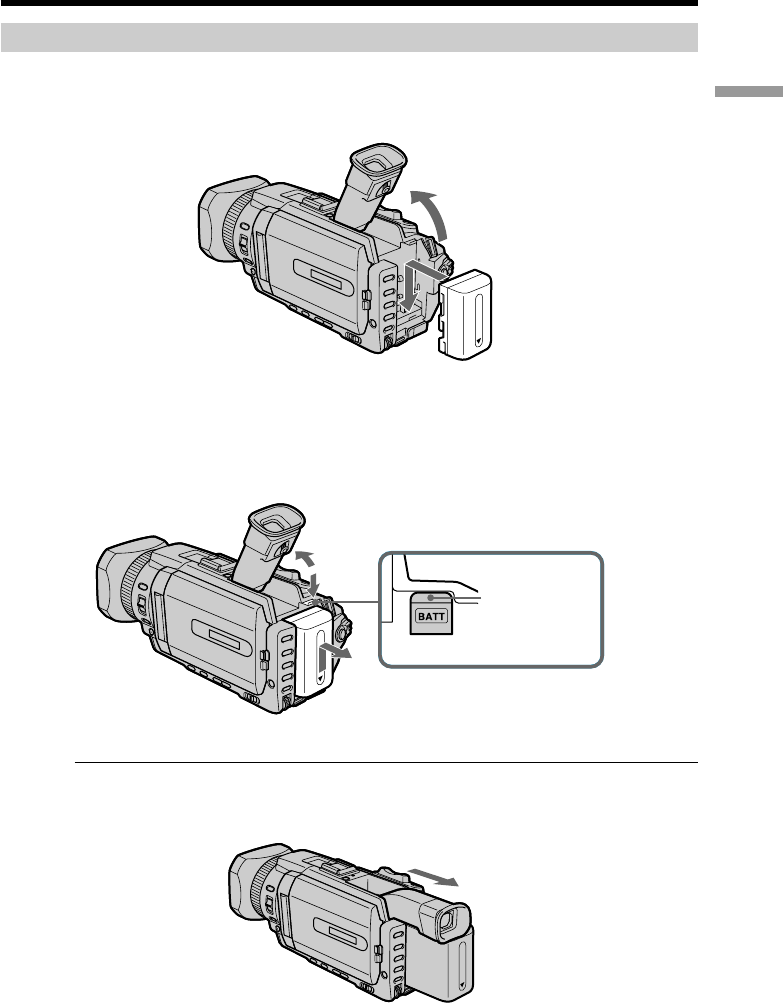
15
Getting Started
Step 1 Preparing the power supply
Installing the battery pack
(1)Lift up the viewfinder.
(2)Slide the battery pack down until it clicks.
To remove the battery pack
(1)Lift up the viewfinder.
(2)Slide the battery pack out in the direction of the arrow while pressing BATT
down.
If you use the large capacity battery pack
If you install the NP-FM70/QM71/FM90/FM91/QM91 battery pack on your camcorder,
extend its viewfinder.
BATT release
button
2
1
1
2
2
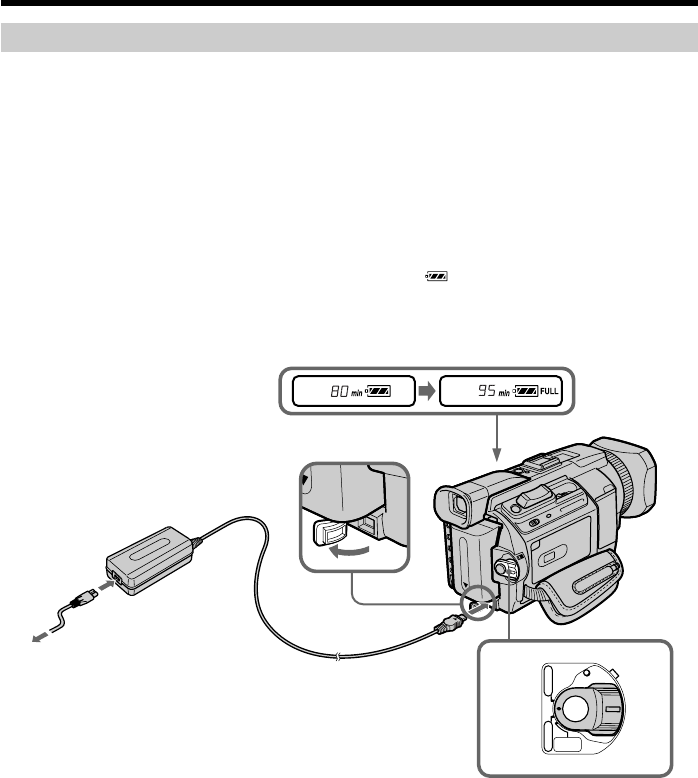
16
Step 1 Preparing the power supply
Charging the battery pack
Use the battery pack after charging it for your camcorder.
Your camcorder operates only with the “InfoLITHIUM” battery pack (M series).
See page 231 for details of “InfoLITHIUM” battery pack.
(1)Open the DC IN jack cover and connect the AC power adaptor supplied with
your camcorder to the DC IN jack with the plug’s v mark facing up.
(2)Connect the power cord to the AC power adaptor.
(3)Connect the power cord to the wall outlet.
(4)Set the POWER switch to OFF (CHG). Charging begins. The remaining battery
time is indicated in minutes on the display window.
When the remaining battery indicator changes to , normal charge is completed. To
fully charge the battery (full charge), leave the battery pack attached for about one hour
after normal charge is completed until FULL appears in the display window. Fully
charging the battery allows you to use the battery longer than usual.
After charging the battery pack
Disconnect the AC power adaptor from the DC IN jack on your camcorder.
2
14
POWER
OFF(CHG)
CAMERA
MEMORY/
NETWORK
VCR

17
Getting Started
Step 1 Preparing the power supply
Note
Prevent metallic objects from coming into contact with the metal parts of the DC plug of
the AC power adaptor. This may cause a short-circuit, damaging the AC power
adaptor.
Remaining battery time indicator
The remaining battery time indicator in the display window indicates the approximate
recording time with the viewfinder.
Until your camcorder calculates the actual remaining battery time
“---- min” appears in the display window.
When you use the AC power adaptor
Place the AC power adaptor near a wall outlet. If any trouble occurs with this unit,
disconnect the plug from a wall outlet as soon as possible to cut off the power.
Charging time
Battery pack Full charge (Normal charge)
NP-FM50 (supplied) 150 (90)
NP-FM70 240 (180)
NP-QM71 260 (200)
NP-FM90 330 (270)
NP-FM91/QM91 360 (300)
Approximate minutes at 25°C (77°F) to charge an empty battery pack
The charging time may increase if the battery’s temperature is extremely high or low
because of the ambient temperature.
Recording time Recording with Recording with
Battery pack the viewfinder the LCD screen
Continuous Typical* Continuous Typical*
NP-FM50 (supplied) 95 50 75 40
NP-FM70 175 100 135 75
NP-QM71 200 115 155 85
NP-FM90 310 175 240 140
NP-FM91/QM91 360 205 280 160
Approximate minutes when you use a fully charged battery
*Approximate number of minutes when recording while you repeat recording start/
stop, zooming and turning the power on/off. The actual battery life may be shorter.

18
Step 1 Preparing the power supply
Playing time
Battery pack Playing time Playing time
with LCD closed on LCD screen
NP-FM50 (supplied) 180 115
NP-FM70 310 205
NP-QM71 350 235
NP-FM90 550 365
NP-FM91/QM91 635 425
Approximate minutes when you use a fully charged battery
Note
Approximate recording time and playing time at 25°C (77°F). The battery life will be
shorter if you use your camcorder in a cold environment.
If the power goes off although remaining battery time indicator indicates that the
battery pack has enough power to operate
Charge the battery pack fully again so that the indication on the battery remaining
indicator is correct.
Recommended charging temperature
We recommend charging the battery pack in an ambient temperature of between 10°C
to 30°C (50°F to 86°F).
What is ”InfoLITHIUM”?
The “InfoLITHIUM” is a lithium ion battery pack that can exchange data such as
battery consumption with compatible electronic equipment. This unit is compatible
with the “InfoLITHIUM” battery pack (M series). Your camcorder operates only with
the “InfoLITHIUM” battery. “InfoLITHIUM” M series battery packs have the
SERIES
TM
mark.
“InfoLITHIUM” is a trademark of Sony Corporation.
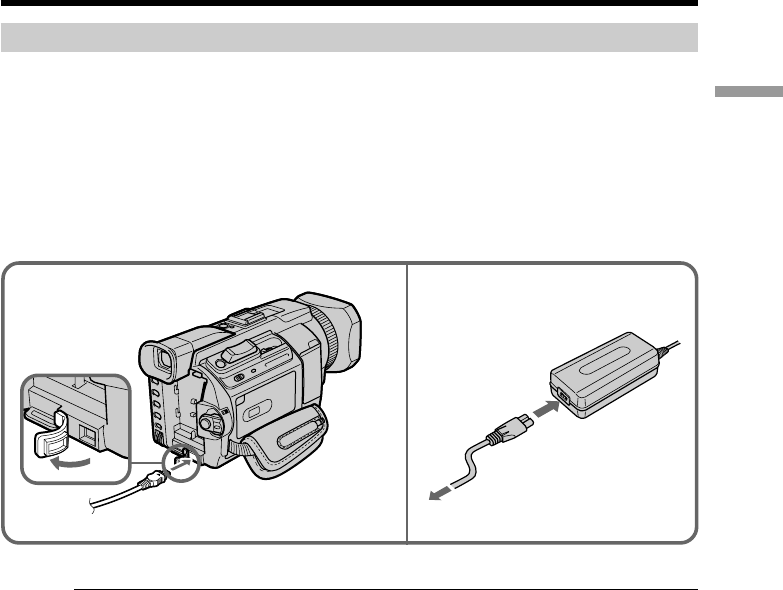
19
Getting Started
Connecting to a wall outlet
When you use your camcorder for a long time, we recommend that you power it from a
wall outlet using the AC power adaptor.
(1)Open the DC IN jack cover. Connect the AC power adaptor supplied with
your camcorder to the DC IN jack on your camcorder with the plug’s v mark
facing up.
(2)Connect the power cord to the AC power adaptor.
(3)Connect the power cord to a wall outlet.
PRECAUTION
The set is not disconnected from the AC power supply (house current) as long as it is
connected to the wall outlet, even if the set itself has been turned off.
Notes
•The AC power adaptor can supply power even if the battery pack is attached to your
camcorder.
•The DC IN jack has “source priority.” This means that the battery pack cannot supply
any power if the power cord is connected to the DC IN jack, even when the power
cord is not plugged into a wall outlet.
Using a car battery
Use Sony Car Battery Adaptor (optional).
Refer to the operating instructions of the Car Battery Adaptor for further information.
Step 1 Preparing the power supply
2,3
1

20
Set the date and time when you use your camcorder for the first time. “CLOCK SET”
will be displayed each time that you set the POWER switch to CAMERA or MEMORY/
NETWORK (DCR-TRV950 only) unless you set the date and time settings.
If you do not use your camcorder for about four months, the date and time may be
cleared from memory (bars may appear) because the built-in rechargeable battery
installed in your camcorder will have been discharged (p. 239).
Set the area, the daylight saving time, year, month, day, hour and then the minute, in
that order.
(1)Press MENU to display the menu settings while the POWER switch is set to
CAMERA or MEMORY/NETWORK (DCR-TRV950 only).
(2)Turn the SEL/PUSH EXEC dial to select , then press the dial.
(3)Turn the SEL/PUSH EXEC dial to select CLOCK SET, then press the dial.
(4)Turn the SEL/PUSH EXEC dial to select the desired area (where you are), then
press the dial.
(5)Turn the SEL/PUSH EXEC dial to select whether or not the time is daylight
saving time, then press the dial.
Select OFF if the time is not daylight saving time. Select ON if it is.
(6)Turn the SEL/PUSH EXEC dial to select the desired year, then press the dial.
The year changes as follows:
(7)Set the month, day and hour by turning the SEL/PUSH EXEC dial and
pressing the dial.
(8)Set the minute by turning the SEL/PUSH EXEC dial and pressing the dial by
the time signal. The clock starts to move.
(9)Press MENU to make the menu settings disappear.
1995 T · · · · t 2002 T · · · · t 2079
Step 2 Setting the date and time
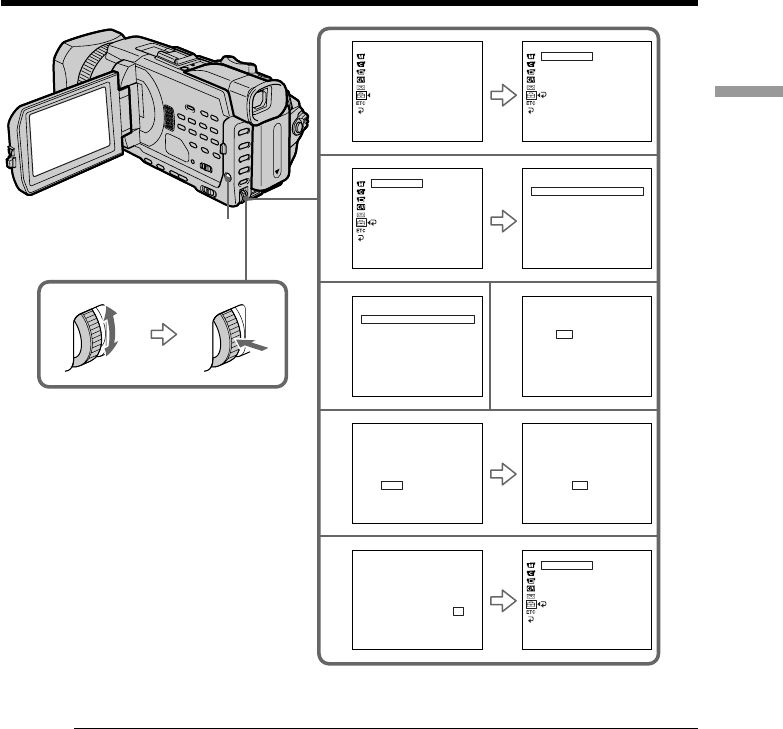
21
Getting Started
Note
Instead of DST, SUMMERTIME is displayed on the screen for some models.
If you do not set the date and time
“--:--:--” and “--- -- ----” are recorded on the data code of the tape and the “Memory
Stick.”
When using your camcorder abroad
Set the clock to the local time (p. 22).
If you use the camcorder in a region where daylight saving time is used
Set DST SET to ON in the menu setting.
Note on the time indicator
The internal clock of your camcorder operates on a 12-hour cycle.
•12:00 AM stands for midnight.
•12:00 PM stands for noon.
Step 2 Setting the date and time
2
3
45
6
8
SETUP MENU
CLOCK SET
USB STREAM
LTR SIZE
LANGUAGE
DEMO MODE
SETUP MENU
CLOCK SET
USB STREAM
LTR SIZE
LANGUAGE
DEMO MODE
RETURN
[MENU] : END
[MENU] : END
[MENU] : END
– –:– –:– –
– –:– –:– –
SETUP MENU
CLOCK SET
USB STREAM
LTR SIZE
LANGUAGE
DEMO MODE
RETURN
DST OFF
DATE Y M D
GMT +0.0
Lisbon, London
CLOCK SET
AREA 1
R
r
R
r
R
RRR RRR
RRR RRR
r
rrr rrr
rrr rrr
[EXEC] : NEXT ITEM
[EXEC] : NEXT ITEM
CLOCK SET
AREA26 GMT –5.0
GMT –5.0
R
GMT –5.0
NewYork, Bogota
NewYork, Bogota
r
NewYork, Bogota
DST OFF
DATE Y M D
DST OFF
DATE Y M D
DST OFF
DATE Y M D
[EXEC] : NEXT ITEM
[EXEC] : NEXT ITEM
[EXEC] : END [MENU] : END
CLOCK SET
AREA26 GMT –5.0
NewYork, Bogota
DATE Y M D
DST OFF
ON
CLOCK SET
AREA26
CLOCK SET
AREA26
2002 JAN 1 12 : 00AM
2002 JUL 4 5 : 30 PM
– – – – – – – – – – – : – – – – – – – – – – – – – : – –
– – – – – – – – – – – : – –
R
RRR RRR
r
rrr rrr
GMT –5.0
NewYork, Bogota
DST OFF
DATE Y M D
[EXEC] : NEXT ITEM
CLOCK SET
AREA26
2002 JAN 1 12 : 00AM
SETUP MENU
CLOCK SET
USB STREAM
LTR SIZE
LANGUAGE
DEMO MODE
RETURN
JUL 4 2002
5:30:00 PM
STBY
STBY
STBY
MENU
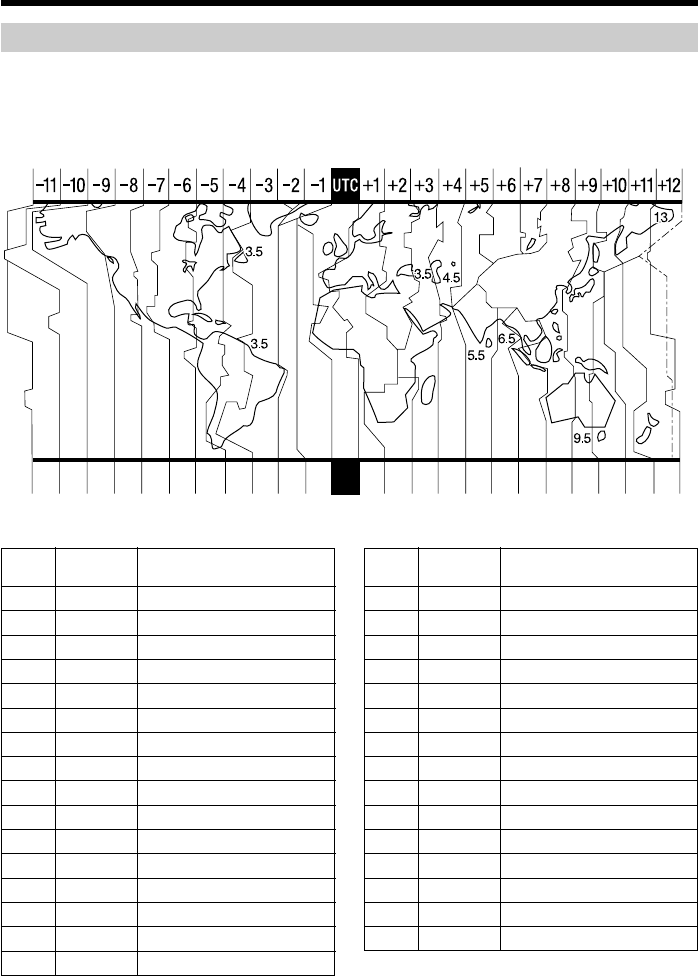
22
Step 2 Setting the date and time
AREA
1
2
3
4
5
6
7
8
9
10
11
12
13
14
15
16
Time
difference
GMT
+01:00
+02:00
+03:00
+03:30
+04:00
+04:30
+05:00
+05:30
+06:00
+06:30
+07:00
+08:00
+09:00
+09:30
+10:00
Area or country
Lisbon, London
Berlin, Paris
Helsinki, Cairo
Moscow, Nairobi
Tehran
Abu Dhabi, Baku
Kabul
Karachi, Islamabad
Calcutta, New Delhi
Almaty, Dhaka
Rangoon
Bangkok, Jakarta
Hongkong, Singapore
Seoul, Tokyo
Adelaide, Darwin
Melbourne, Sydney
AREA
17
18
19
20
21
22
23
24
25
26
27
28
29
30
31
Time
difference
+11:00
+12:00
–12:00
–11:00
–10:00
–09:00
–08:00
–07:00
–06:00
–05:00
–04:00
–03:30
–03:00
–02:00
–01:00
Area or country
Solomon Is
Fiji, Wellington
Eniwetok, Kwajalein
Midway Is., Samoa
Hawaii
Alaska
LosAngeles, Tijuana
Denver, Arizona
Chicago, MexicoCity
New York, Bogota
Santiago
St. John’s
Brasilia, Montevideo
Fernando de Noronha
Azores
To adjust a time difference
Select AREA SET in the menu setting, and select an area or a country you want to adjust
to, then press SEL/PUSH EXEC dial.
19 20 21 22 23 24 25 26 2729 30 31 12346810121314161718
Simple setting of clock by a time difference
You can easily set the clock to the local time by setting a time difference. Select AREA
SET, DST SET* in the menu settings. See page 216 for more information.
*Instead of DST, SUMMERTIME is displayed on the screen for some models.
World time differences
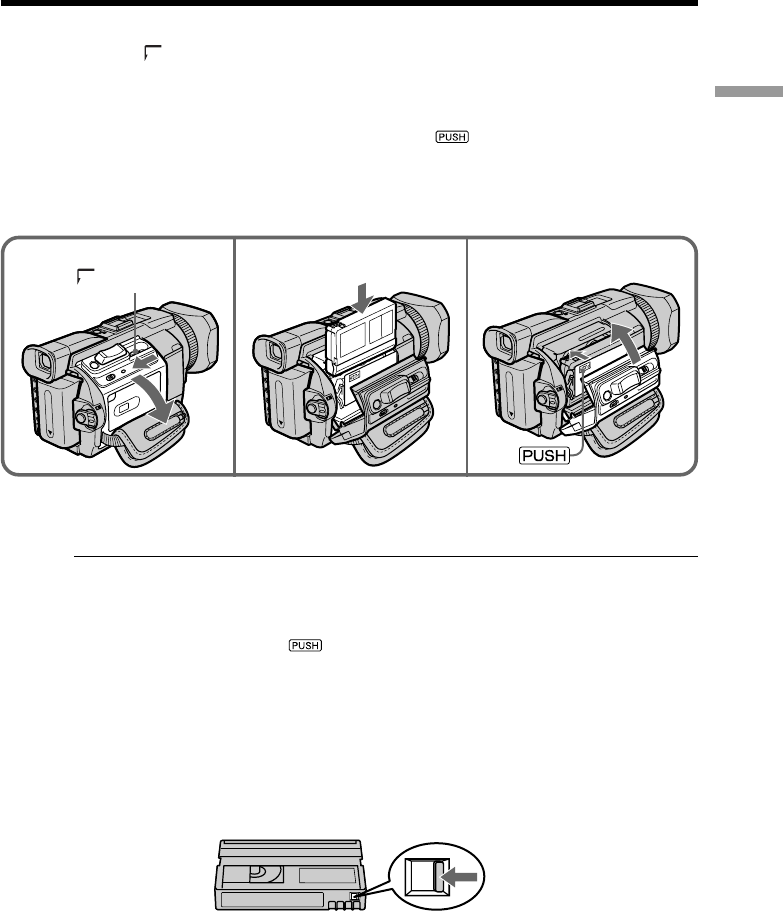
23
Getting Started
(1)Prepare the power supply.
(2)Slide OPEN/Z EJECT in the direction of the arrow and open the lid.
The cassette compartment automatically lifts up and opens.
(3)Insert the cassette straight as far as possible into the cassette compartment with
the window facing out and the write-protect tab facing upward.
(4)Close the cassette compartment by pressing on the cassette compartment.
The cassette compartment automatically goes down.
(5)After the cassette compartment goes down completely, close the lid until it
clicks.
To eject a cassette
Follow the procedure above, and take out the cassette in step 3.
Notes
•Do not press the cassette compartment down forcibly. Doing so may cause a
malfunction.
•The cassette compartment may not be closed when you press any part of the cassette
compartment other than the mark.
When you use a cassette with cassette memory
Read the instruction about cassette memory to use this function properly (p. 228).
To prevent accidental erasure
Slide the write-protect tab on the cassette to expose the red mark.
Step 3 Inserting a cassette
34, 52 OPEN/Z EJECT
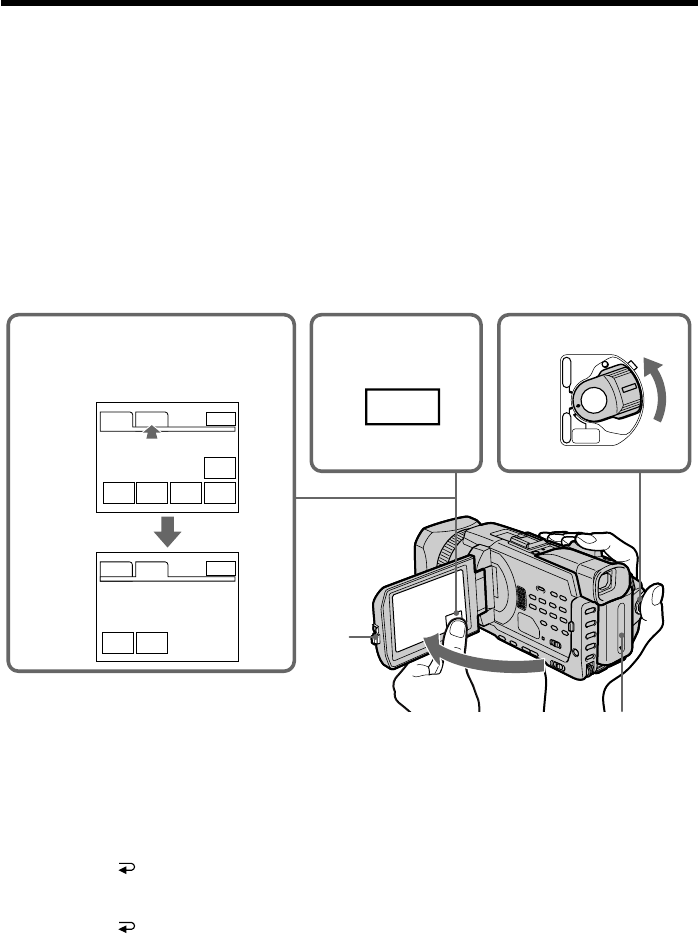
24
Your camcorder has operation buttons on the LCD screen. Touch the LCD screen
directly with your finger or the supplied stylus (DCR-TRV950 only) to operate each
function. This section describes how to operate the touch panel during recording or
playing back images on a tape.
(1)Prepare the power supply (p. 15 to 19).
(2)Press OPEN to open the LCD panel.
(3)Set the POWER switch to CAMERA or VCR while pressing the small green
button.
(4)Press FN. Operation buttons appear on the LCD screen.
(5)Press PAGE2 to go to PAGE2. Operation buttons appear on the LCD screen.
(6)Press a desired operation item. Refer to relevant pages of this manual for each
function.
To return to FN
Press EXIT.
To execute settings
Press OK. The display returns to PAGE1/PAGE2.
To cancel settings
Press OFF to return to PAGE1/PAGE2.
34
1
2
FN
POWER
OFF(CHG)
CAMERA
MEMORY/
NETWORK
VCR
5,6
PAGE1 PAGE2
EXIT
END
SCH
SPOT
FOCUS DIG
EFFT MEM
M I X SPOT
METER
SELF
TIMER
LCD
BRT
PAGE1 PAGE2
EXIT
Step 4 Using the touch panel
When the POWER switch
is set to CAMERA
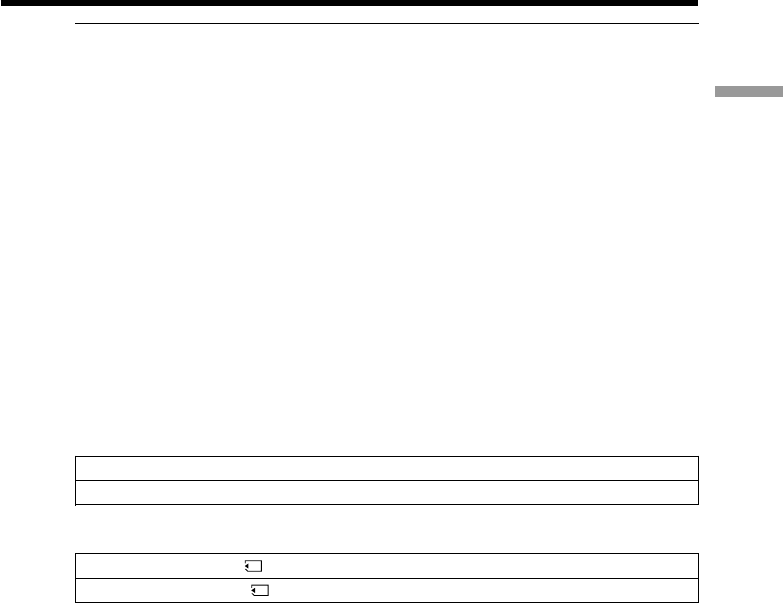
25
Getting Started
Step 4 Using the touch panel
Notes
•When using the touch panel, press operation buttons with your thumb supporting the
LCD panel from the back side of it or press those buttons lightly with your index
finger.
•Do not press the LCD screen with sharp-pointed objects other than the supplied
stylus. (DCR-TRV950 only)
•Do not press the LCD screen too hard.
•Do not touch the LCD screen with wet hands.
•If FN is not on the LCD screen, touch the LCD screen lightly to make it appear. You
can control the display with DISPLAY/TOUCH PANEL on your camcorder.
•When operation buttons do not work even if you press them, an adjustment is
required (CALIBRATION) (p. 238).
•When the LCD screen gets dirty, clean it with the supplied cleaning cloth.
When executing each item
The green bar appears above the item.
If the items are not available
The color of the items changes to gray.
Press FN to display the following buttons:
When the POWER switch is set to CAMERA
PAGE1 END SCH, SPOT FOCUS, DIG EFFT, MEM MIX, SPOT METER
PAGE2 LCD BRT, SELFTIMER
When the POWER switch is set to VCR
PAGE1 LCD BRT, PB, INDEX, END SCH
PAGE2 PB ZOOM, PB, INDEX, DIG EFFT
See page 129 when the POWER switch is set to MEMORY/NETWORK (DCR-TRV950
only).
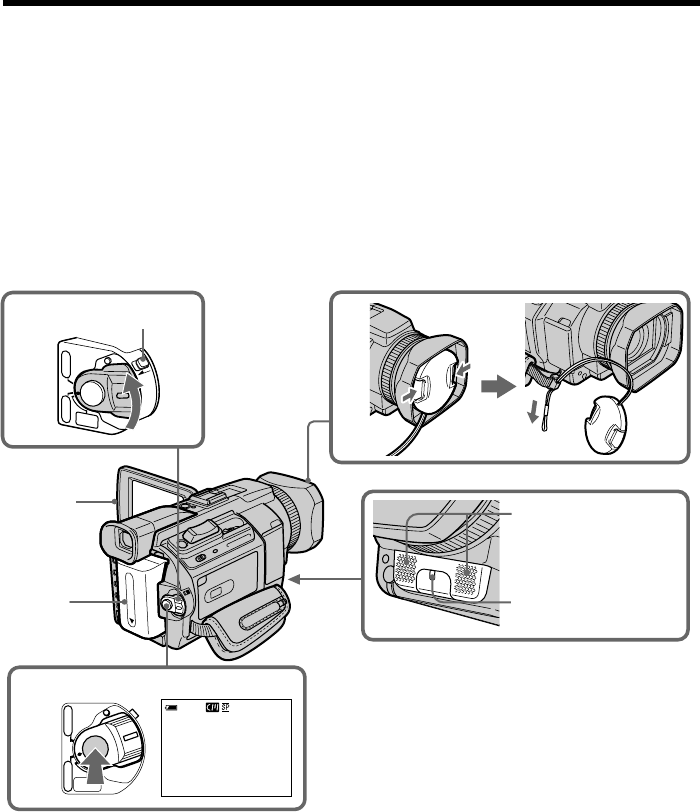
26
5
2
4
40min
REC
0:00:01
3
LOCK
CAMERA
VCR
OFF(CHG)
POWER
MEMORY/
NETWORK
POWER
OFF(CHG)
CAMERA
MEMORY/
NETWORK
VCR
1
Your camcorder automatically focuses for you.
(1)Remove the lens cap by pressing both knobs on its sides and pull the lens cap
string to fix it.
(2)Prepare the power supply and insert a cassette. See “Step 1” to “Step 3” for
more information (p. 15 to 23).
(3)Set the POWER switch to CAMERA while pressing the small green button.
This sets your camcorder to the standby.
(4)Press OPEN to open the LCD panel. The viewfinder automatically turns off.
(5)Press START/STOP. Your camcorder starts recording. The REC indicator
appears. The camera recording lamp located on the front of your camcorder
lights up. To stop recording, press START/STOP again.
LOCK switch
Microphone
Camera recording
lamp
— Recording – Basics —
Recording a picture

27
Recording – Basics
Notes
•Fasten the grip strap firmly.
•The recording data (date/time or various settings when recorded) are not displayed
while recording. However, they are recorded automatically on the tape. To display the
recording data, press the DATA CODE button during playback you can also use the
Remote Commander for this operation (p. 41).
Note on recording
Your camcorder records and plays back in the SP (standard play) mode and in the LP
(long play) mode. Select SP or LP in the menu settings (p. 214). In the LP mode, you can
record 1.5 times as long as in the SP mode.
When you record a tape in the LP mode on your camcorder, we recommend playing
back the tape on your camcorder.
Note on the LOCK switch
When you slide the LOCK switch in the direction of the arrow, the POWER switch can
no longer be set to MEMORY/NETWORK (DCR-TRV950 only) accidentally. The LOCK
switch is set to the further side (unlock position) as the default setting.
To enable smooth transition
Transition between the last scene you recorded and the next scene is smooth as long as
you do not eject the cassette even if you turn off your camcorder.
However, check the following:
–Do not mix recordings in the SP mode and in the LP mode on one tape.
–When you change the battery pack, set the POWER switch to OFF (CHG).
–When you use a cassette with cassette memory, however, you can make the transition
smooth even after ejecting the cassette if you use the END SEARCH (p. 37).
If you leave your camcorder in the standby for five minutes while the cassette is
inserted
Your camcorder automatically turns off. This is to save battery power and to prevent
battery and tape wear. To return to the standby, set the POWER switch to OFF (CHG)
and then back to CAMERA. To start recording, press the START/STOP button again
without switching the POWER switch. However, your camcorder does not turn off
automatically while the cassette is not inserted.
When you record in the SP and LP modes on one tape or you record in the LP
mode
•The transition between scenes may not be smooth.
•The playback picture may be distorted or the time code may not be written properly
between scenes.
The battery use time when you record using the LCD screen
The battery time is slightly shorter than the shooting time using the viewfinder.
Recording a picture
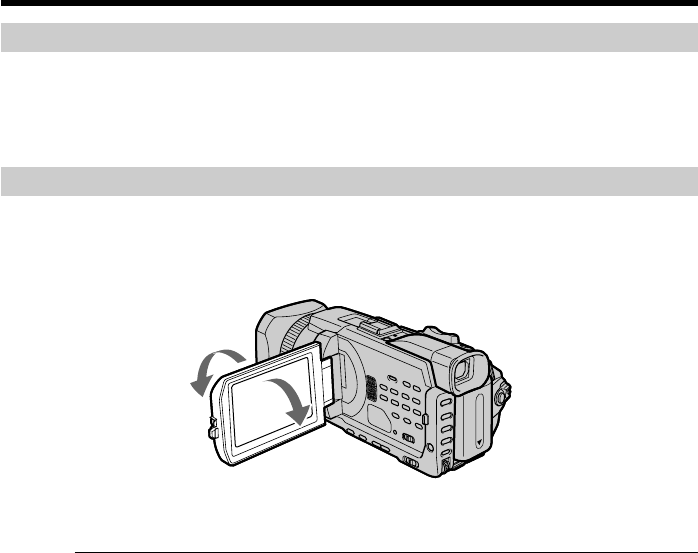
28
Recording a picture
After recording
(1)Set the POWER switch to OFF (CHG).
(2)Close the LCD panel.
(3)Eject the cassette.
(4)Remove the battery pack.
Adjusting the LCD screen
The LCD panel can be opened up to 90 degrees.
The LCD panel moves about 90 degrees to the viewfinder side and about 180 degrees to
the lens side.
When closing the LCD panel, set it vertically, and swing it into the camcorder body.
Note
When the LCD panel is opened, the viewfinder automatically turns off and no image is
displayed in the viewfinder. However, in the Mirror Mode, images are displayed in the
viewfinder as well (p. 32).
LCD screen
•When you use the LCD screen outdoors in direct sunlight, the LCD screen may be
difficult to see. If this happens, we recommend that you use the viewfinder.
•When you adjust the angle of the LCD panel, make sure if the LCD panel is opened up
to 90 degrees.
180°
90°
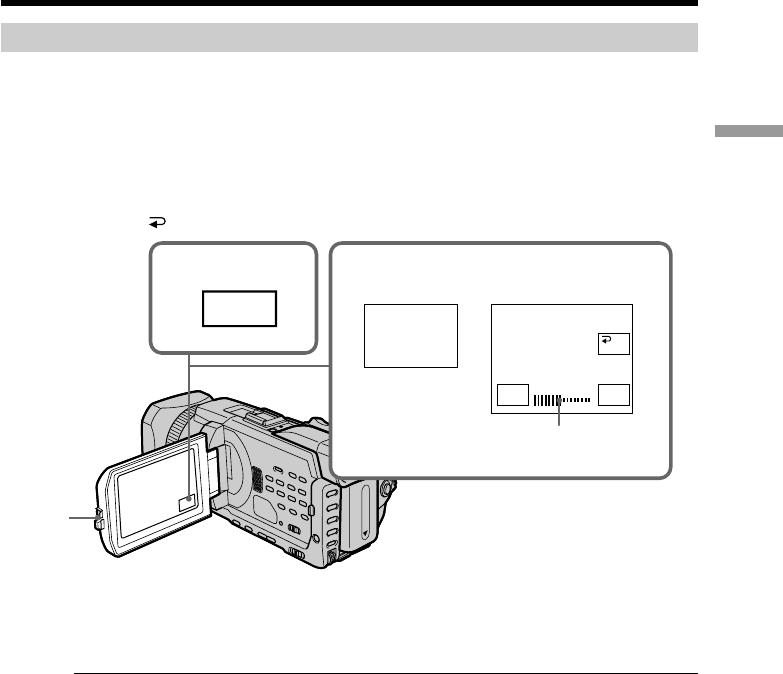
29
Recording – Basics
Adjusting the brightness of the LCD screen
(1)Press FN and select PAGE2 while the POWER switch is set to CAMERA or
MEMORY/NETWORK (DCR-TRV950 only).
When you set the POWER switch to VCR, press FN to display PAGE1.
(2)Press LCD BRT. The screen to adjust the brightness of the LCD screen appears.
(3)Adjust the brightness of the LCD screen using –/+.
–:to dim
+:to brighten
(4)Press OK to return to PAGE1/PAGE2.
To return to FN
Press EXIT.
LCD screen backlight
You can change the brightness of the backlight. Select LCD B.L. in the menu settings
when using the battery pack (p. 210).
Even if you adjust LCD BRT
The recorded picture will not be affected.
12,3
FN
LCD
BRT
LCD BRT
–+
OK
Recording a picture
OPEN
the bar indicator
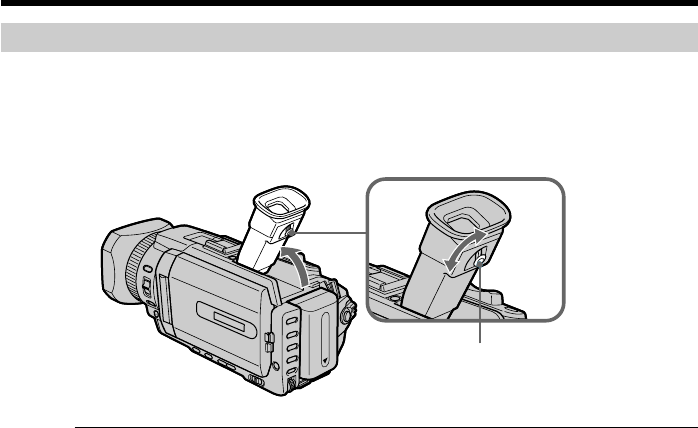
30
Recording a picture
Adjusting the viewfinder
If you record pictures with the LCD panel closed, check the picture with the viewfinder.
Adjust the viewfinder lens to your eyesight so that the images in the viewfinder come
into sharp focus.
Lift up the viewfinder and move the viewfinder lens adjustment lever.
Viewfinder backlight
You can change the brightness of the backlight. Select VF B.L. in the menu settings
when using the battery pack (p. 210).
The viewfinder lens
adjustment lever
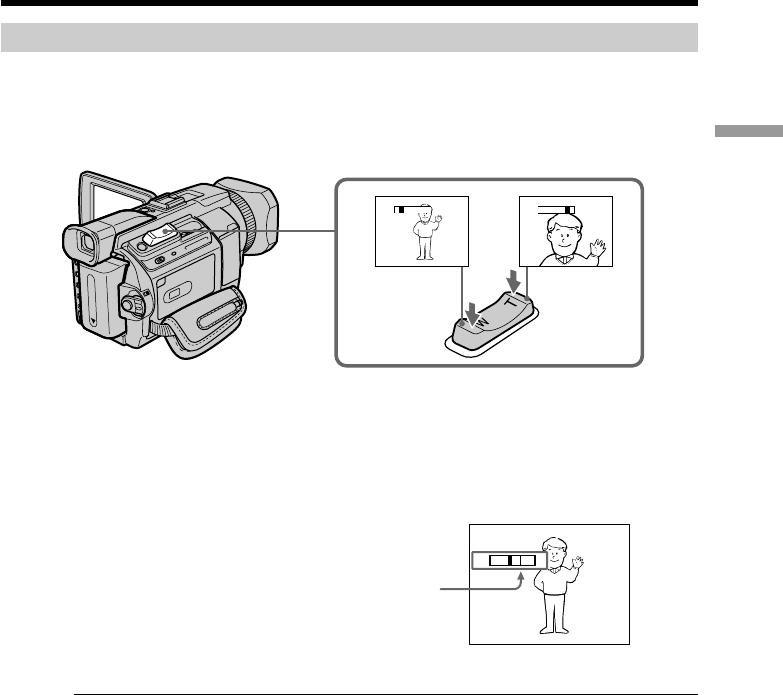
31
Recording – Basics
Using the zoom feature
Move the power zoom lever a little for a slower zoom. Move it further for a faster zoom.
Using the zoom sparingly results in better-looking recordings.
W: Wide-angle (subject appears farther away)
T: Telephoto (subject appears closer)
To use zoom greater than 12×
Zoom greater than 12× is performed digitally. Digital zoom can be set to 24× or 150×.
To activate digital zoom, select the digital zoom power in D ZOOM in the menu
settings (p. 209). The digital zoom is set to OFF as a default setting.
When you shoot close to a subject
If you cannot get a sharp focus, move the power zoom lever to the “W” side until the
focus is sharp. You can shoot a subject that is at least about 80 cm (about 2 feet 5/8 inch)
away from the lens surface in the telephoto position, or about 1 cm (about 1/2 inch)
away in the wide-angle position.
Note on digital zoom
The picture quality deteriorates as you move the power zoom lever towards the “T”
side.
When the POWER switch is set to MEMORY/NETWORK (DCR-TRV950 only)
You cannot use the digital zoom.
Recording a picture
T
WT
W
T
W
The right side of the bar shows the digital zooming
zone.
The digital zooming zone appears when you select
the digital zoom power in the menu settings.
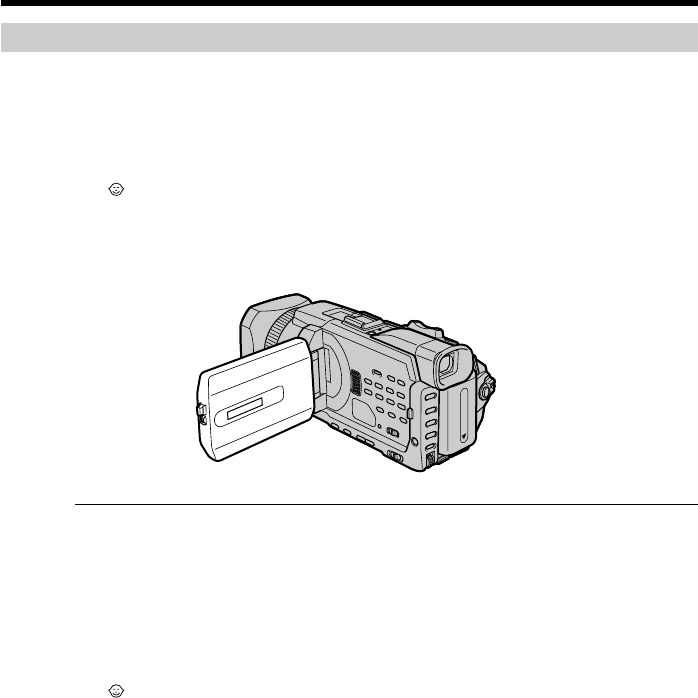
32
Shooting with the Mirror Mode
This feature allows the camera subject to view him-or herself on the LCD screen.
The subject uses this feature to check his or her own image on the LCD screen while
you look at the subject in the viewfinder.
Set the POWER switch to CAMERA or MEMORY/NETWORK (DCR-TRV950 only).
Rotate the LCD screen 180 degrees.
The indicator appears in the viewfinder and on the LCD screen.
Xz appears in the standby, and z appears in the recording while the POWER switch
is set to CAMERA. Some of other indicators appear mirror-reversed and others are not
displayed.
Picture in the mirror mode
The picture on the LCD screen is a mirror-image. However, the picture will be normal
when recorded.
During recording in the mirror mode
•ZERO SET MEMORY on the Remote Commander does not work.
•FN appears mirror-reversed in the viewfinder.
When you press FN
The does not appear on the screen.
Recording a picture
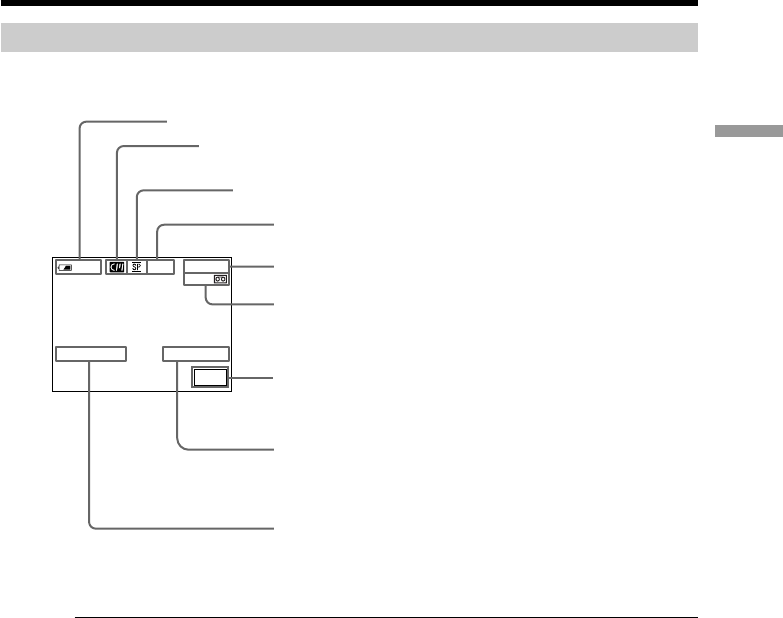
33
Recording – Basics
Indicators displayed in the recording
Indicators are not recorded on tapes.
Remaining battery time indicator during recording
The remaining battery time indicator roughly indicates the continuous recording time.
The indicator may not be correct, depending on the conditions in which you are
recording. When you close the LCD panel and open it again, it takes about one minute
for the correct remaining battery time in minutes to be displayed.
Time code
The time code indicates the recording or playback time, “0:00:00” (hours : minutes :
seconds) in CAMERA and “0:00:00:00” (hours : minutes : seconds : frames) in VCR.
You cannot rewrite only the time code.
Remaining tape indicator
The indicator may not be displayed accurately depending on the tape.
Recording data
The recording data (date/time or various settings when recorded) are not displayed
while recording. However, they are recorded automatically on the tape. To display the
recording data, press the DATA CODE button during playback. You can also use the
Remote Commander for this operation (p. 41).
Recording a picture
0:00:01
45min
50min
REC
JUL 4 2002 12:05:56PM
FN
Recording mode
Cassette memory
This appears when using a cassette with cassette memory.
Time
The time is displayed about five seconds after the
power is turned on.
Date
The date is displayed about five seconds after the
power is turned on.
STBY/REC
Remaining battery time
Time code/Tape counter
Remaining tape
This appears after you insert a cassette and record or
play back for a while.
FN button
Press this button to display operation buttons on the
LCD screen.
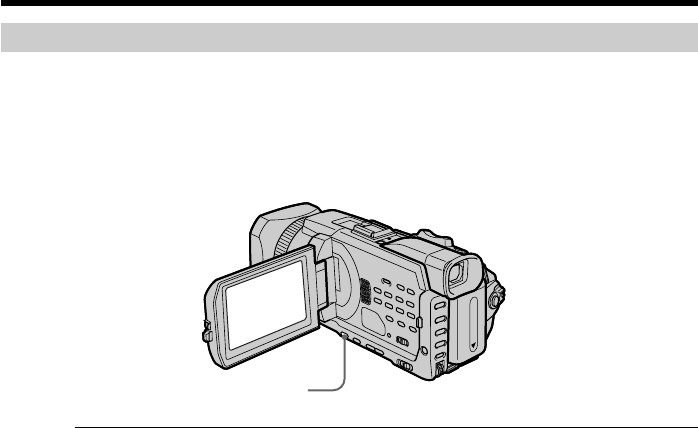
34
Recording a picture
Shooting backlit subjects – BACK LIGHT
When you shoot a subject with the light source behind the subject or a subject with a
light background, use the backlight function.
Press BACK LIGHT while the POWER switch is set to CAMERA or MEMORY/
NETWORK (DCR-TRV950 only).
The . indicator appears on the screen. To cancel, press BACK LIGHT again.
When shooting backlit subjects
If you press SPOT LIGHT, EXPOSURE or SPOT METER, the backlight function will be
canceled.
When you manually adjust the exposure
You cannot use the backlight function.
BACK LIGHT
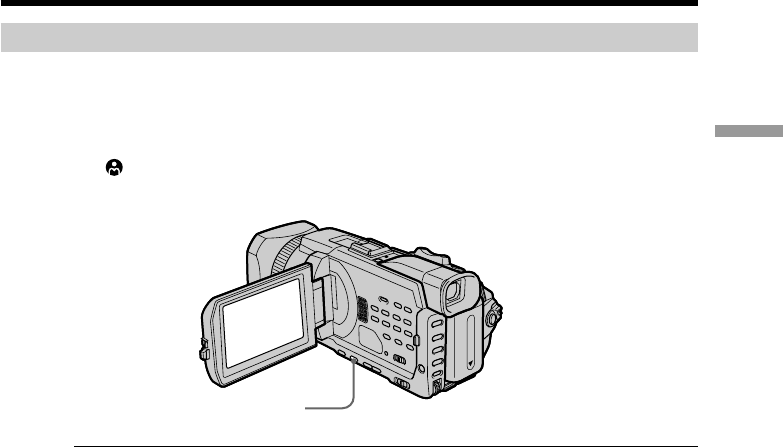
35
Recording – Basics
Recording a picture
Shooting subjects lit by strong light – SPOT LIGHT
This function prevents people's faces, for example, from appearing excessively white
when shooting subjects lit by strong light, such as in the theater.
Press SPOT LIGHT while the POWER switch is set to CAMERA or MEMORY/
NETWORK (DCR-TRV950 only).
The indicator appears on the screen. To cancel, press SPOT LIGHT again.
when shooting spotlighted subjects
If you press BACK LIGHT, EXPOSURE or SPOT METER, the spot light function will be
canceled.
When you manually adjust the exposure
You cannot use the spot light function.
SPOT LIGHT
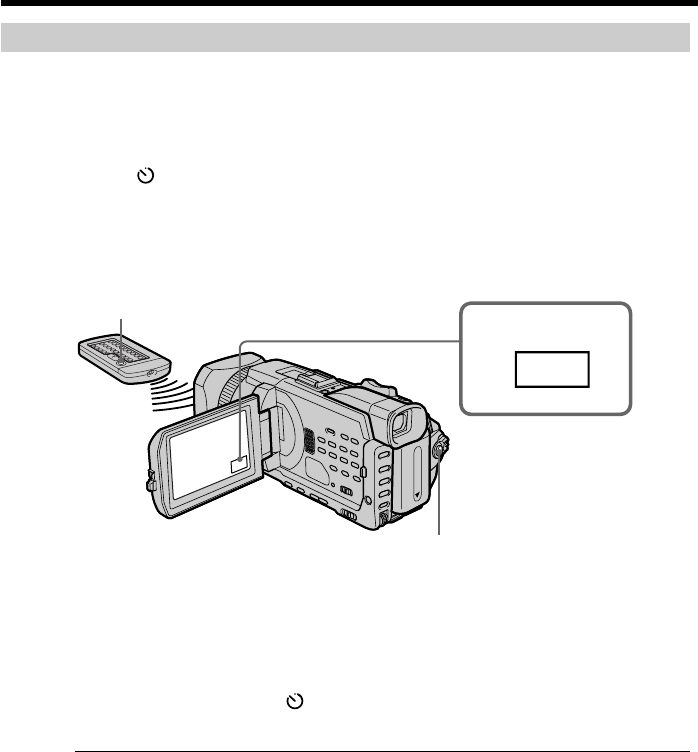
36
Recording a picture
Self-timer recording
Recording with the self-timer starts in 10 seconds automatically. You can also use the
Remote Commander for this operation.
(1)In the standby, press FN and select PAGE2.
(2)Press SELFTIMER.
The (self-timer) indicator appears on the screen.
(3)Press START/STOP.
The self-timer starts counting down from 10 with a beep. In the last two
seconds of the countdown, the beep gets faster, then recording starts
automatically.
To stop the count down
Press START/STOP.
To restart the countdown, press START/STOP again.
To cancel the self-timer
Press SELFTIMER so that the (self-timer) indicator disappears from the screen
while your camcorder is in the standby.
Note
The self-timer is automatically canceled when:
–The self-timer recording is finished.
–The POWER switch is set to OFF (CHG) or VCR.
When the POWER switch is set to MEMORY/NETWORK (DCR-TRV950 only)
You can also record still images on a “Memory Stick” with the self-timer (p. 143).
1FN
START/STOP
START/STOP
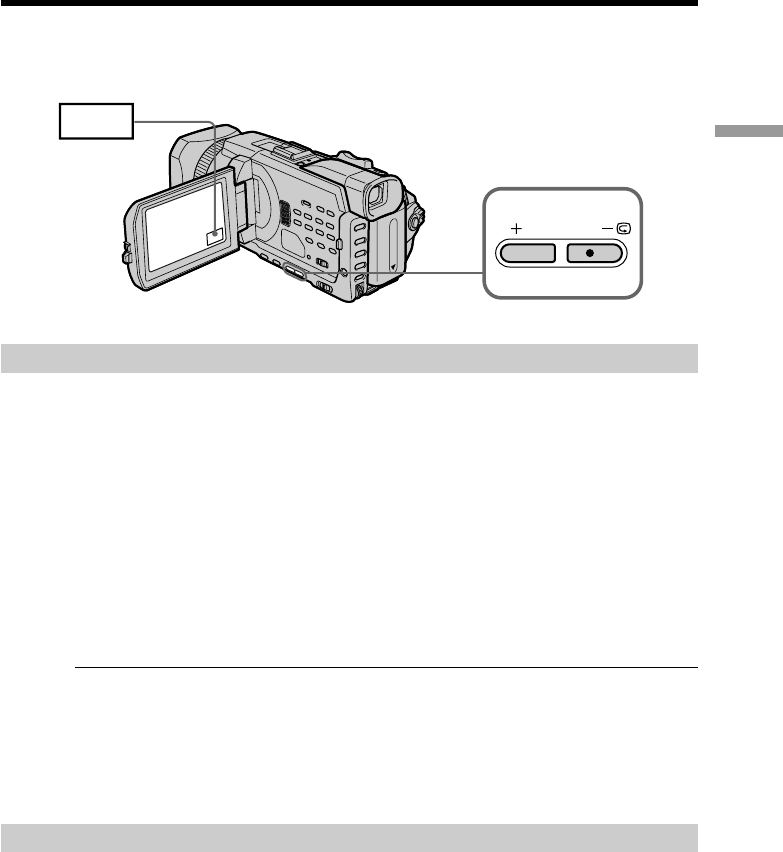
37
Recording – Basics
You can use these buttons to check the recorded picture or shoot so that the transition
between the last recorded scene and the next scene you record is smooth.
END SEARCH
You can go to the end of the recorded section after you record.
(1)In the standby, press FN to display PAGE1.
(2)Press END SCH.
The last five seconds of the recorded section are played back and your
camcorder returns to the standby. You can monitor the sound from the speaker
or headphones.
To return to FN
Press EXIT.
To stop searching
Press END SCH again.
End search
When you use a cassette without cassette memory, the end search function does not
work once you eject the cassette after you have recorded on the tape. If you use a
cassette with cassette memory, the end search works even once you eject the cassette.
If a tape has a blank portion between recorded portions
The end search may not work correctly.
EDITSEARCH
You can search for the next recording start point.
Hold down the EDITSEARCH in the standby. The recorded portion is played back.
– 7 : To go backward
+: To go forward
Release EDITSEARCH to stop playback. If you press START/STOP, recording begins
from the point you released EDITSEARCH. You cannot monitor the sound.
Checking recordings
– END SEARCH / EDITSEARCH / Rec Review
FN
EDITSEARCH

38
Checking recordings – END SEARCH / EDITSEARCH / Rec Review
Rec Review
You can check the last recorded section.
Press the – 7 side of EDITSEARCH momentarily in the standby.
The section you have stopped most recently will be played back for a few seconds, and
then your camcorder will return to the standby. You can monitor the sound from the
speaker or headphones.
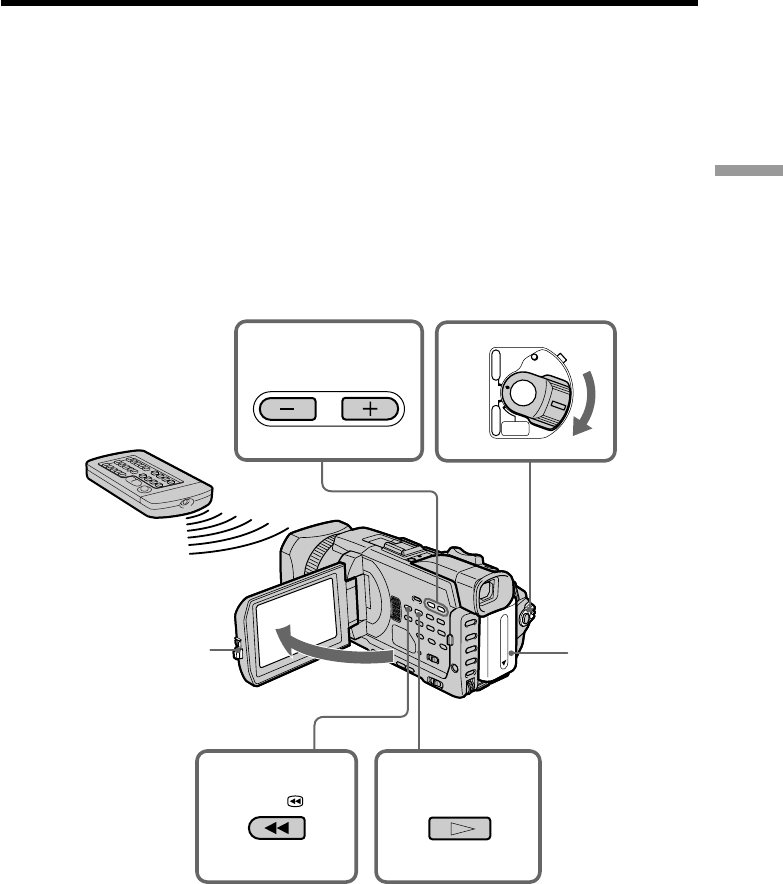
39
Playback – Basics
You can monitor the playback picture on the screen. If you close the LCD panel, you
can monitor the playback picture in the viewfinder. You can control playback using the
Remote Commander supplied with your camcorder.
(1)Prepare the power supply and insert the recorded tape.
(2)Set the POWER switch to VCR while pressing the small green button.
(3)Open the LCD panel while pressing OPEN.
(4)Press m to rewind the tape.
(5)Press N to start playback.
(6)To adjust the volume, press either of the two buttons on VOLUME.
– : To turn down
+ : To turn up
When you close the LCD panel, sound is muted.
To stop playback
Press x.
— Playback – Basics —
Playing back a tape
45
62
1
3
VOLUME
REW PLAY
POWER
OFF(CHG)
CAMERA
MEMORY/
NETWORK
VCR
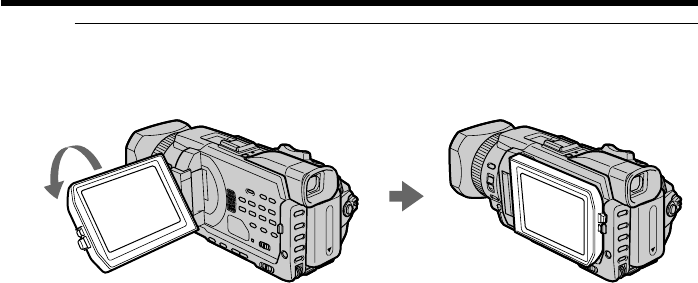
40
When monitoring on the LCD screen
You can turn the LCD panel over and move it back to the camcorder body with the
LCD screen facing out.
If you leave the power on for a long time
Your camcorder gets warm. This is not a malfunction.
When you open or close the LCD panel
Make sure that the LCD panel is set vertically.
Playing back a tape
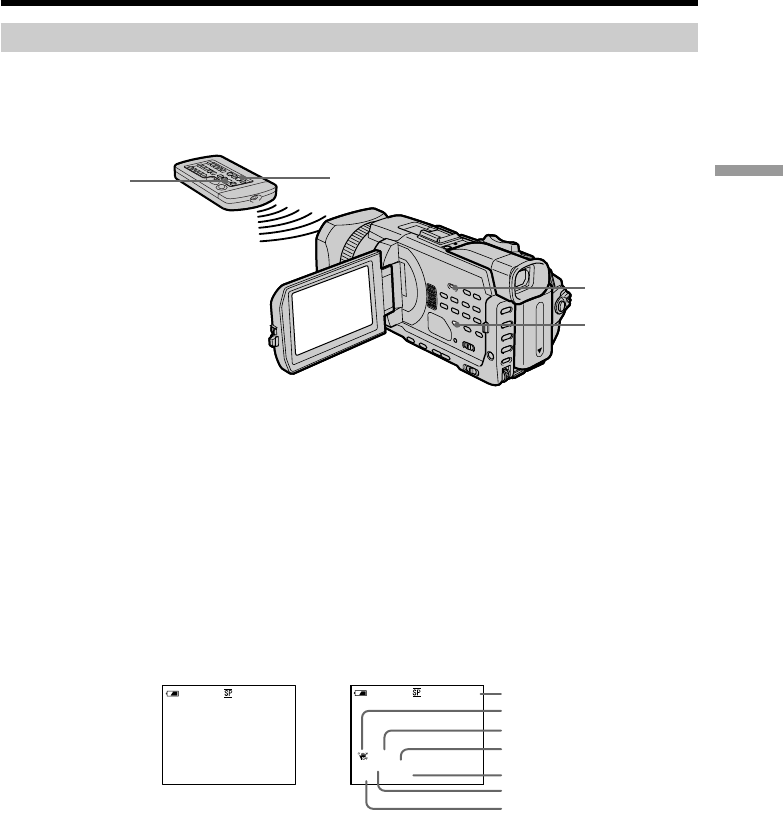
41
Playback – Basics
To display the screen indicators – Display function
Press DISPLAY/TOUCH PANEL on your camcorder or DISPLAY on the Remote
Commander supplied with your camcorder. The indicators disappear on the screen. To
make the indicators appear, press DISPLAY/TOUCH PANEL or DISPLAY again.
About date/time and various settings
Your camcorder automatically records not only images on the tape but also the
recording data (date/time or various settings when recorded) (data code).
1Set the POWER switch to VCR, then play back a tape.
2Press DATA CODE on your camcorder or the Remote Commander.
The display changes as follows when you press the DATA CODE:
date/time t various settings (SteadyShot, exposure, white balance, gain, shutter
speed, aperture value) t no indicator
[a]Tape counter
[b]SteadyShot OFF
[c]Exposure mode
[d]White balance
[e]Gain
[f]Shutter speed
[g]Aperture value
Playing back a tape
DISPLAY/
TOUCH PANEL
DATA CODE
DATA CODE DISPLAY
Date/time Various settings
[g]
[b]
[d]
[e]
[f]
[c]
[a]
60 AWB
F1.8 9dB
AUTO
JUL 4 2002
12:05:56 AM
50min
0:00:23:01
40min
0:00:23:01

42
Playing back a tape
To not display various settings
Set DATA CODE to DATE in the menu settings (p. 216).
The display changes as follows when you press DATA CODE :
date/time y no indicator
Various settings
Various settings are your camcorder’s information when you have recorded. In the
recording, the various settings will not be displayed.
When you use the data code, bars (-- -- --) appear if:
–A blank portion of the tape is being played back.
–The tape is unreadable due to tape damage or noise.
–The tape was recorded by a camcorder without the date and time set.
Data code
When you connect your camcorder to the TV, the data code appears on the TV screen.
Remaining battery time indicator during playback
The indicator indicates the approximate continuous playback time. The indicator may
not be correct, depending on the conditions in which you are playing back. When you
close the LCD panel and open it again, it takes about one minute for the correct
remaining battery time to be displayed.

43
Playback – Basics
Playing back a tape
Various playback modes
To operate video control buttons, set the POWER switch to VCR.
To play back pause (viewing a still picture)
Press X during playback. To resume normal playback, press N or X.
To advance the tape
Press M in the stop mode. To resume normal playback, press N.
To rewind the tape
Press m in the stop mode. To resume normal playback, press N.
To change the playback direction
Press on the Remote Commander during playback to reverse the playback direction.
To resume normal playback, press N.
To locate a scene monitoring the picture (picture search)
Keep pressing m or M during playback. To resume normal playback, release the
button.
To monitor high-speed pictures while advancing or rewinding
the tape (skip scan)
Keep pressing m while rewinding or M while advancing the tape. To resume
rewinding or advancing, release the button.
To view the picture at slow speed (slow playback)
Press y on the Remote Commander during playback. For slow playback in the reverse
direction, press , then press y on the Remote Commander. To resume normal
playback, press N.
To view pictures at double speed
Press ×2 on the Remote Commander during playback. For double speed playback in the
reverse direction, press , then press ×2 on the Remote Commander. To resume
normal playback, press N.
To view pictures frame-by-frame
Press C on the Remote Commander in the playback pause. For frame-by-frame
playback in the reverse direction, press c. To resume normal playback, press N.
To search the last scene recorded (END SEARCH)
Press FN, then press END SCH in the stop mode. The last five-second recorded portion
is played back and then stopped.

44
In the various playback modes
•Sound is muted.
•The previous picture may remain as a mosaic image during playback.
When the playback pause lasts for five minutes
Your camcorder automatically enters the stop mode. To resume playback, press N.
Slow playback
The slow playback can be performed smoothly on your camcorder. However, this
function does not work for an output signal through the DV Interface.
When you play back a tape in reverse
Horizontal noise may appear at the center, or the top and bottom of the screen. This is
not a malfunction.
Playing back a tape
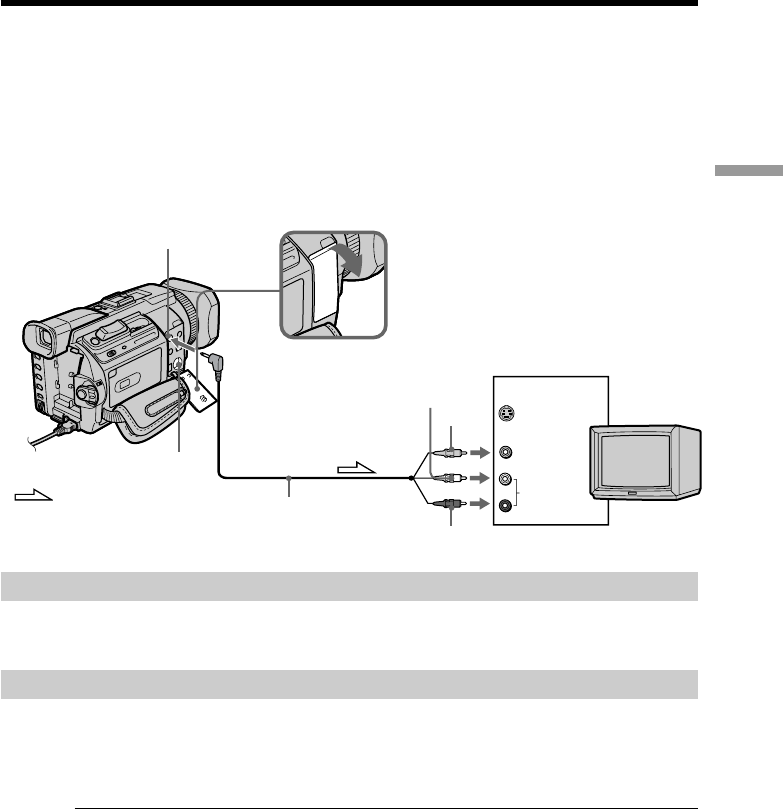
45
Playback – Basics
Connect your camcorder to your TV with the A/V connecting cable supplied with your
camcorder to watch playback picture on the TV screen. You can operate the video
control buttons in the same way as when you monitor playback pictures on the screen.
When monitoring playback pictures on the TV screen, we recommend that you power
your camcorder from a wall outlet using the AC power adaptor (p. 19). Refer to the
operating instructions of your TV.
Open the jack cover. Connect your camcorder to the TV with the A/V connecting cable
supplied with your camcorder. Then, set the TV/VCR selector on the TV to VCR.
If your TV is already connected to a VCR
Connect your camcorder to the LINE IN input on the VCR by using the A/V connecting
cable supplied with your camcorder. Set the input selector on the VCR to LINE.
If your TV or VCR is a monaural type
Connect the yellow plug of the A/V connecting cable to the video input jack and the
white or the red plug to the audio input jack on the VCR or the TV. If you connect the
white plug, the sound is L (left) signal. If you connect the red plug, the sound is R
(right) signal.
If your TV has an S video jack
Pictures can be reproduced more faithfully by using an S video cable (optional). With
this connection, you do not need to connect the yellow (video) plug of the A/V
connecting cable. Connect the S video cable (optional) to the S video jacks on both your
camcorder and the TV.
This connection produces higher quality DV format pictures.
To display the screen indicators on TV
Set DISPLAY to V-OUT/LCD in the menu settings (p. 217).
Then, press DISPLAY/TOUCH PANEL on your camcorder. To turn the screen
indicators off, press DISPLAY/TOUCH PANEL on your camcorder again.
Viewing the recording on TV
TV
S VIDEO
AUDIO/VIDEO
S VIDEO
VIDEO
AUDIO
IN
: Signal flow
Yellow
White
Red
A/V connecting cable (supplied)
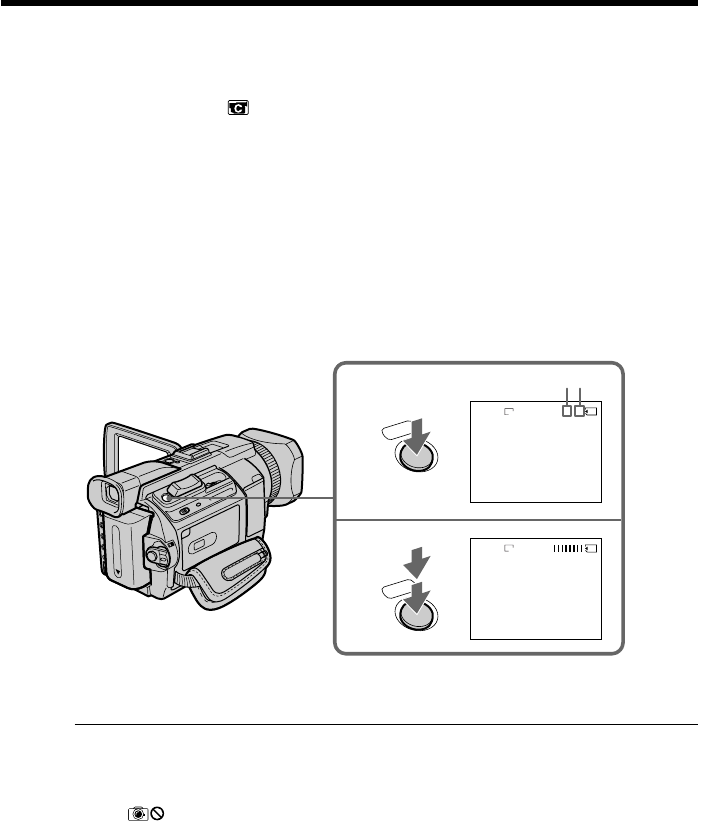
46
You can record still images on a “Memory Stick” in the tape recording or tape recording
standby. You can also record still images on a tape (p. 51).
Before operation
•Insert a “Memory Stick” into your camcorder.
•Set PHOTO REC in to MEMORY in the menu settings (The default setting is
MEMORY).
(1)In the standby, keep pressing PHOTO lightly until a still image appears. The
CAPTURE indicator appears. Recording does not start yet. To change from the
selected still image to another image, release PHOTO once and press it lightly
again.
(2)Press PHOTO deeper.
Recording is complete when the bar scroll indicator disappears.
The image while pressing the button deeply is recorded on the “Memory
Stick.”
Notes
•When recording a still image, do not shake your camcorder. If you do so, the image
may flutter.
•You cannot record still images on a “Memory Stick” during following operations
( The indicator flashes on the screen.):
–Wide mode
–Fader
–Picture effect
–Digital effect
–MEMORY MIX
“Memory Stick”
For details, see page 126 for more information.
— Advanced Recording Operations —
Recording still images on a “Memory
Stick” during tape recording
1
2
PHOTO
PHOTO
1 / 6
CAPTURE
SFN
640
SFN
640
[a] : Number of the recorded images
[b] : Approximate number of the images that can be recorded on the “Memory Stick”
[a][b]

47
Advanced Recording Operations
Image size of still images
Image size is automatically set to 640 × 480.
When you want to record still images in different size, use the Memory Photo recording
(p. 135).
When the POWER switch is set to CAMERA
You cannot select image quality.
The image quality when you set the POWER switch to MEMORY/NETWORK (DCR-
TRV950 only) is used. (The default setting is SUPER FINE).
During and after recording still images on a “Memory Stick”
Your camcorder continues recording on tape.
When you press PHOTO on the Remote Commander
Your camcorder immediately records the image that is on the screen when you press
the button.
To record still images on a “Memory Stick” during tape recording
You cannot check an image on the screen by pressing PHOTO lightly. The image when
you press PHOTO will be recorded on the “Memory Stick.”
To record images with higher quality
We recommend that you use the Memory Photo recording (p. 135).
Title
The title cannot be recorded.
Recording still images on a “Memory Stick” during tape recording
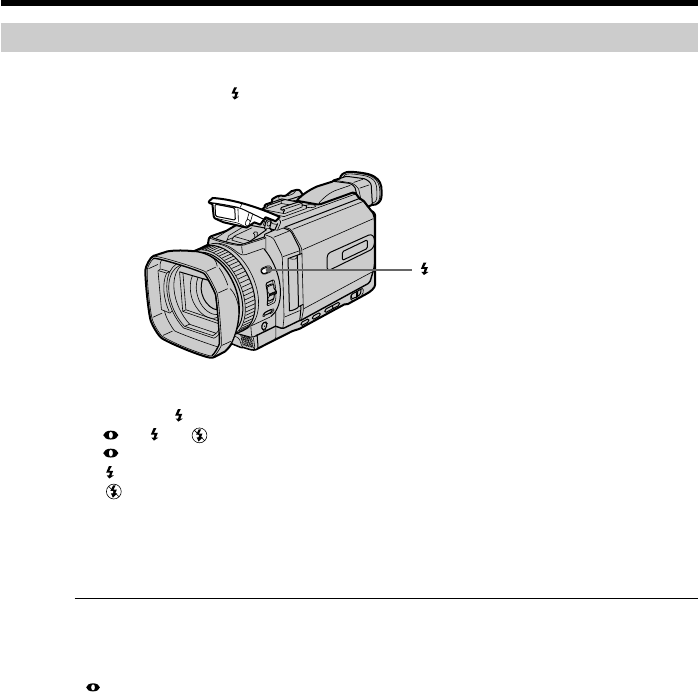
48
Recording still images on a “Memory Stick” during tape recording
Recording images with the flash
The flash pops up automatically. The default setting is auto (no indicator). To change
the flash mode, press (flash) repeatedly until the flash mode indicator appears on the
screen.
Each press of (flash) changes the indicator as follows:
t t t (no indicator)
Auto red-eye reduction: The flash fires before recording to reduce red-eye.
Forced flash: The flash fires regardless of the surrounding brightness.
No flash: The flash does not fire.
The flash is automatically adjusted to the appropriate brightness. You can also change
FLASH LVL to the desired brightness in the menu settings (p. 208). Try recording
various images to find the most appropriate setting for FLASH LVL.
Notes
•Attaching the lens hood or a conversion lens (optional) may block the light from the
flash or cause lens shadow to appear.
•You cannot use an external flash (optional) and the built-in flash at the same time.
• (auto red-eye reduction) may not produce the desired effect depending on
individual differences, the distance to the subject, the subject not looking at the pre-
recording flash or other conditions.
•A flash effect cannot be obtained easily when you use forced flash in a bright location.
•When recording with the flash, it takes longer to prepare for image capture. This is
because your camcorder starts to charge power for firing after the flash pops up.
Darken the surroundings by covering the lens, and press PHOTO lightly so that your
camcorder starts to charge power after the flash pops up.
•If it is not easy to focus on the subject automatically, for example, when recording in
the dark, use the focal distance information (p. 77) for focusing manually.
When the flashlight does not reach to the subject
The color of the image may change.
If you leave your camcorder for five or more minutes after removing the power
supply
Your camcorder returns to the default setting (auto).
(flash)

49
Advanced Recording Operations
Recording still images on a “Memory Stick” during tape recording
You cannot shoot images with the flash during the following operations:
–Tape Recording
–Shutter speed (1/30 or smaller) adjustment
The flash does not fire even if you select auto (no indicator) and (auto red-eye
reduction) during the following operations:
–Spot light
–Shutter speed adjustment
–Sunset & moon of PROGRAM AE
–Landscape of PROGRAM AE
–Exposure
–Flexible Spot Meter
When you use an external flash (optional) which does not have the auto red-eye
reduction
You cannot select the auto red-eye reduction.
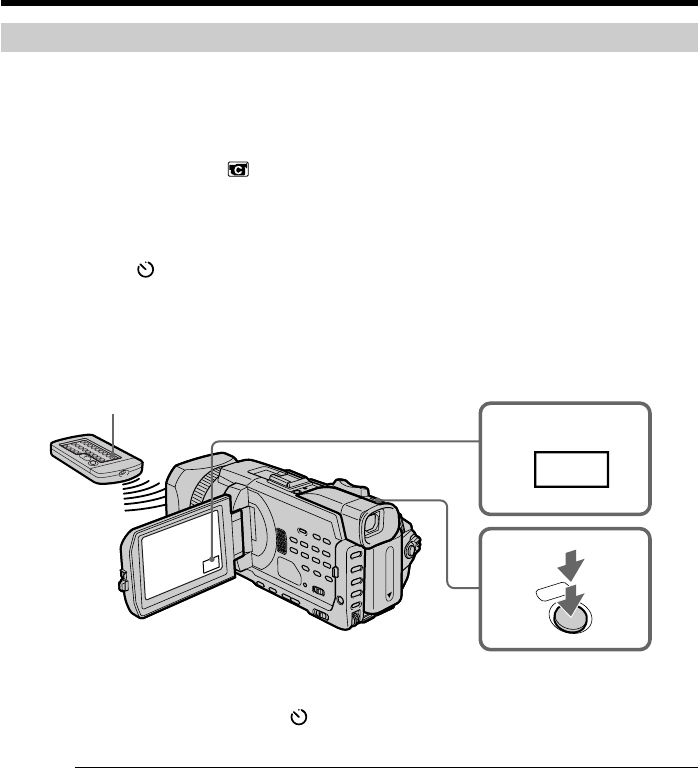
50
Recording still images on a “Memory Stick” during tape recording
Self-timer recording
You can record still images on a “Memory Stick” with the self-timer. You can also use
the Remote Commander for this operation.
Before operation
•Insert a “Memory Stick” into your camcorder.
•Set PHOTO REC in to MEMORY in the menu settings.(The default setting is
MEMORY.)
(1)In the standby, press FN and select PAGE2.
(2)Press SELFTIMER.
The (self-timer) indicator appears on the screen.
(3)Press PHOTO deeper.
The self-timer starts counting down from 10 with a beep. In the last two
seconds of the countdown, the beep gets faster, then the recording starts
automatically.
To cancel the self-timer
Press SELFTIMER so that the (self-timer) indicator disappears from the screen while
your camcorder is in the standby. You cannot stop the count down.
Note
The self-timer is automatically canceled when:
–The self-timer is finished.
–The POWER switch is set to OFF (CHG) or VCR.
Self-timer recording
You can operate the self-timer recording only during the recording standby.
3
PHOTO
1FN
PHOTO
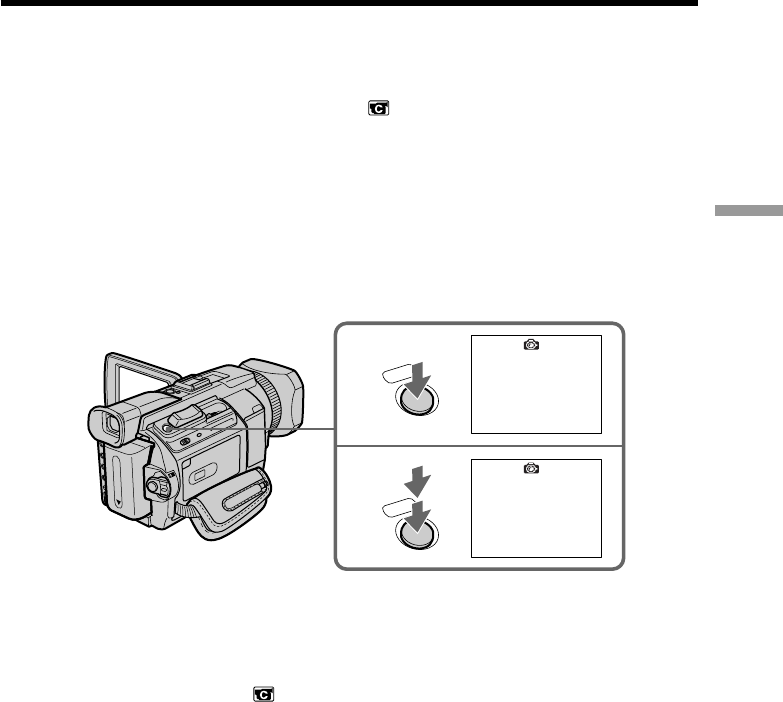
51
Advanced Recording Operations
You can record still images such as photographs on tapes.
You can record about 510 images in the SP mode and about 765 images in the LP mode
on a 60-minute tape.
(1)In the standby, set PHOTO REC in to TAPE in the menu settings.
(2)Keep pressing PHOTO lightly until a still image appears.
The CAPTURE indicator appears. Recording does not start yet.
To change from the selected still image to another image, release PHOTO once
and press it lightly again.
(3)Press PHOTO deeper.
The still image on the screen is recorded for about seven seconds. The sound
during those seven seconds is also recorded.
The still image is displayed on the screen until recording is completed.
Recording images with the flash
For the details, see page 48.
Recording images with self-timer
(1)Set PHOTO REC in to TAPE in the menu settings (p. 209).
(2)Follow steps 1 and 3 on page 50.
Recording still images on a tape
– Tape Photo recording
2
•••••••
3
CAPTURE
PHOTO
PHOTO

52
Recording still images on a tape – Tape Photo recording
Notes
•During tape photo recording, you cannot change the mode or setting.
•When recording a still image, do not shake your camcorder. If you do so, the image
may flutter.
•You cannot use PHOTO during the following operations: ( The indicator flashes
on the screen.)
–Fader
–Digital effect
•When you record images with the flash, sound may not be recorded clearly.
If you record a moving subject with the tape photo recording
When you play back the still image on other equipment, the image may flutter. This is
not a malfunction.
When you press PHOTO on the Remote Commander
Your camcorder immediately records the image that is on the screen when you press
the button.
To use the tape photo recording during the tape recording
You cannot check an image on the screen by pressing PHOTO lightly. Press PHOTO
deeper. The still image is then recorded for about seven seconds, and your camcorder
returns to the standby.
To record clear still images with little unsteadiness
We recommend that you record on a “Memory Stick” using the Memory Photo
recording.
When you record images with the flash
The allowed shooting distance is shorter than when you record on a “Memory Stick” in
Memory Photo recording.
When playing back images recorded with the flash on other equipment
These images may flicker.
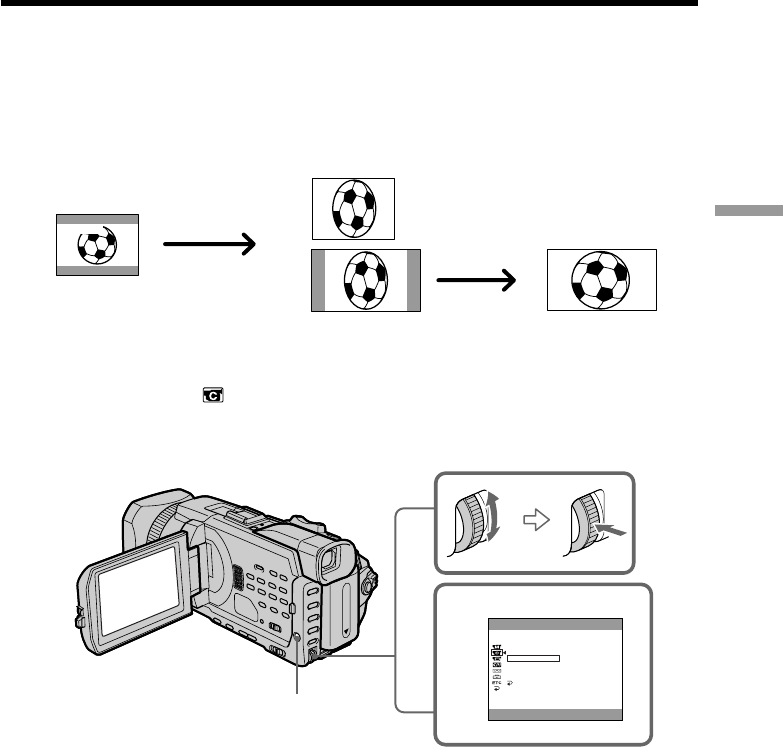
53
Advanced Recording Operations
You can record a 16:9 wide picture to watch on a 16:9 wide-screen TV (16:9WIDE). If
you connect a TV compatible with the ID-1/ID-2 system, the screen size is
automatically selected.
Black bands appear on the screen during recording in 16:9WIDE mode [a]. The picture
during playback on a normal TV [b] or on a wide-screen TV [c] is compressed in the
longwise direction. If you set the screen mode of the wide-screen TV to the full mode,
you can watch pictures of normal images [d].
(1)In the standby, press MENU, then turn the SEL/PUSH EXEC dial to select
16:9WIDE in , then press the dial (p. 209).
(2)Turn the SEL/PUSH EXEC dial to select ON, then press the dial.
To cancel the wide mode
Set 16:9WIDE to OFF in the menu settings.
Using the wide mode
2
ON
CAMERA SET
D ZOOM
PHOTO REC
16:9WIDE
STEADYSHOT
FRAME REC
INT. REC
RETURN
[MENU] : END
MENU
[a]
[c]
[b]
[d]
16:9
WIDE

54
In the wide mode
You cannot select the following functions:
–Recording still images on a “Memory Stick” in the tape recording or recording
standby
–BOUNCE
–OLD MOVIE
During recording
You cannot select or cancel the wide mode. When you cancel the wide mode, set your
camcorder to the standby and then set 16:9WIDE to OFF in the menu settings.
Connection for a TV
Pictures recorded in the 16:9WIDE mode automatically appear on the TV screen at full
size when:
–You connect your camcorder to a TV that is compatible with the video ID (ID-1/ID-2)
system.
–You connect your camcorder to the S video jack on the TV.
ID-1 system
The ID-1 system sends aspect ratio (screen horizontal/vertical ratio) information (16:9,
4:3, or letter box) with video signals.
ID-2 system
The ID-2 system sends a copyright protection signal with ID-1 signals inserted between
video signals when you connect your camcorder to other equipment using an A/V
connecting cable.
Using the wide mode
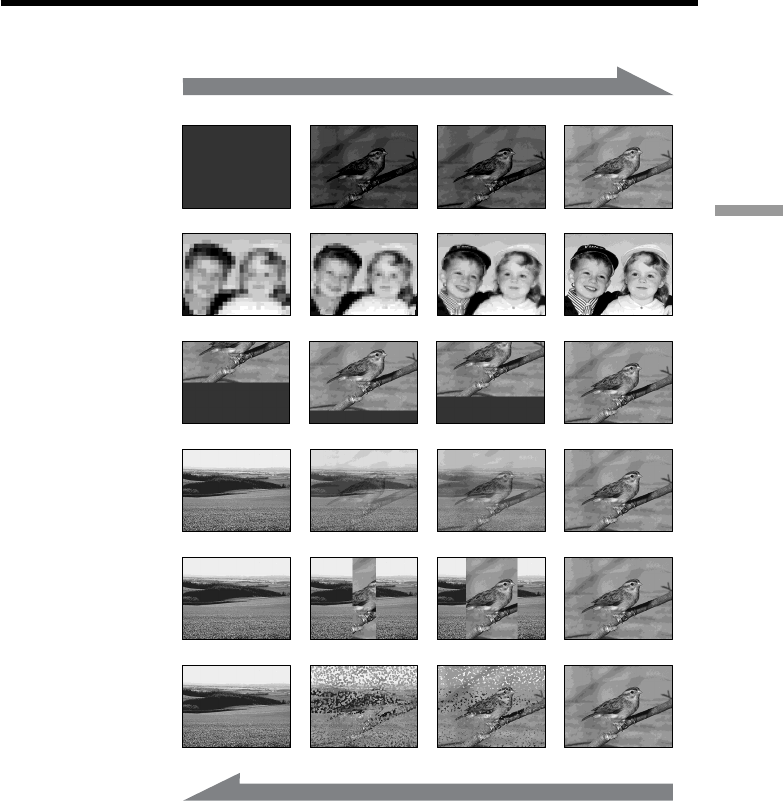
55
Advanced Recording Operations
You can fade in or out to give your recording a more professional appearance.
MONOTONE
When fading in, the picture gradually changes from black-and-white to color.
When fading out, the picture gradually changes from color to black-and-white.
1) You can use the bounce when D ZOOM is set to OFF in the menu settings.
2) Fade in only.
Using the fader
FADER
OVERLAP2)
WIPE2)
DOT2)
M. FADER
(mosaic)
BOUNCE1) 2)
[a]
RECSTBY
RECSTBY
[b]
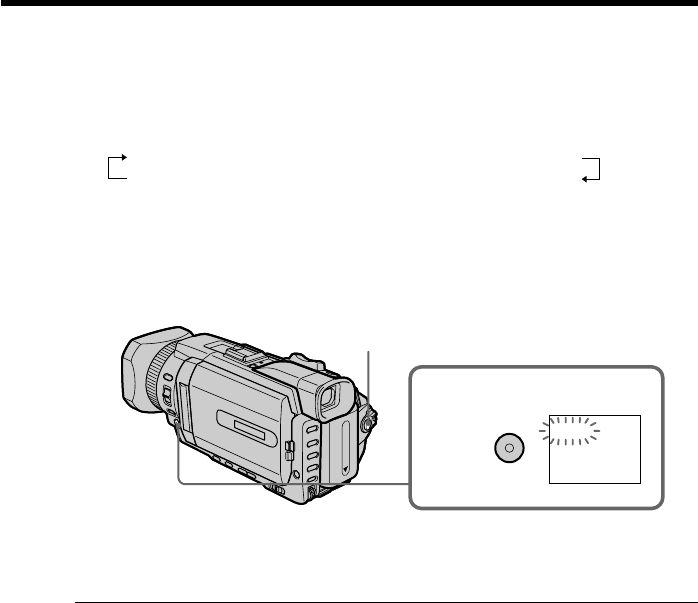
56
(1)When fading in [a]
In the standby, press FADER until the desired fader indicator flashes.
When fading out [b]
In the recording, press FADER until the desired fader indicator flashes.
The indicator changes as follows:
FADER tM. FADER tBOUNCE tMONOTONE
(no indicator)TDOT TWIPE TOVERLAP
The last selected fader is indicated first of all.
(2)Press START/STOP. The fader indicator stops flashing.
After fade in/out ends, your camcorder automatically returns to the normal
mode.
To cancel the fader
Before pressing START/STOP, press FADER until the indicator disappears.
Note
You cannot use the following functions while using the fader. Also, you cannot use the
fader while using the following functions:
–Recording still images on a “Memory Stick” in the tape recording or recording
standby
–Tape photo recording
–Digital effect
–Interval recording
–Frame recording
When you select OVERLAP, WIPE, or DOT
Your camcorder automatically stores the image recorded on a tape. While the image is
being stored, the indicators flash fast, and the playback picture disappears. At this
stage, the picture may not be recorded clearly, depending on the tape condition.
Using the fader
START/STOP
1
FADER
FADER

57
Advanced Recording Operations
When you set the POWER switch to MEMORY/NETWORK (DCR-TRV950 only)
You cannot use the fader.
While using BOUNCE, you cannot use the following functions:
–Zoom
–Picture effect
–Shutter speed adjustment
–Exposure
–Flexible Spot meter
–Focus manually
–Spot Focus
Note on BOUNCE
The BOUNCE indicator does not appear in the following mode or functions:
–When D ZOOM is activated in the menu settings
–Wide mode
–Picture effect
–PROGRAM AE
Using the fader
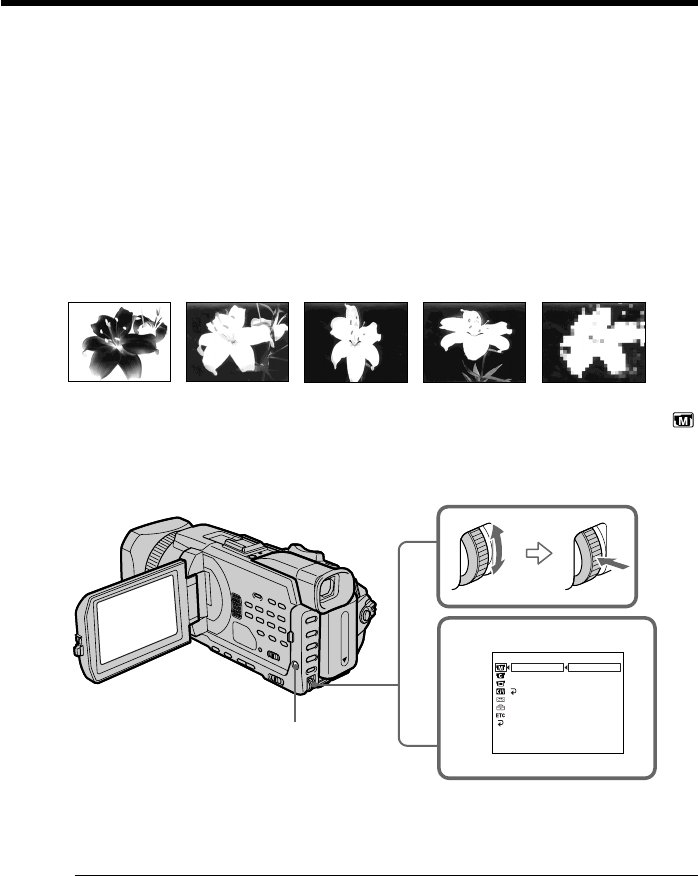
58
You can digitally process images to obtain special effects like those in films or on TV.
NEG. ART [a] : The color and brightness of the picture are reversed.
SEPIA : The picture appears in sepia.
B&W : The picture appears in monochrome (black-and-white).
SOLARIZE [b] : The light intensity becomes clearer, to make the picture look more like
an illustration.
SLIM [c] : The picture expands vertically.
STRETCH [d] : The picture expands horizontally.
MOSAIC [e] : The picture appears mosaic-patterned.
(1)Set the POWER switch to CAMERA. Press MENU, then select P EFFECT in
with the SEL/PUSH EXEC dial, then press the dial (p. 208).
(2)Turn the SEL/PUSH EXEC dial to select the desired mode, then press the dial.
To cancel the picture effect
Set P EFFECT to OFF in the menu settings.
Note
The following functions do not work during the picture effect
–Recording still images on a “Memory Stick” in the tape recording or recording
standby
–BOUNCE
–OLD MOVIE
When you set the POWER switch to OFF (CHG)
Picture effect is automatically canceled.
[a] [b] [c] [d] [e]
1
MANUAL SET
P EFFECT
FLASH LVL
AUTO SHTR
RETURN
OFF
NEG. ART
SEPIA
B&W
SOLARIZE
SLIM
STRETCH
MOSAIC
[MENU] : END
MENU
Using special effects – Picture effect
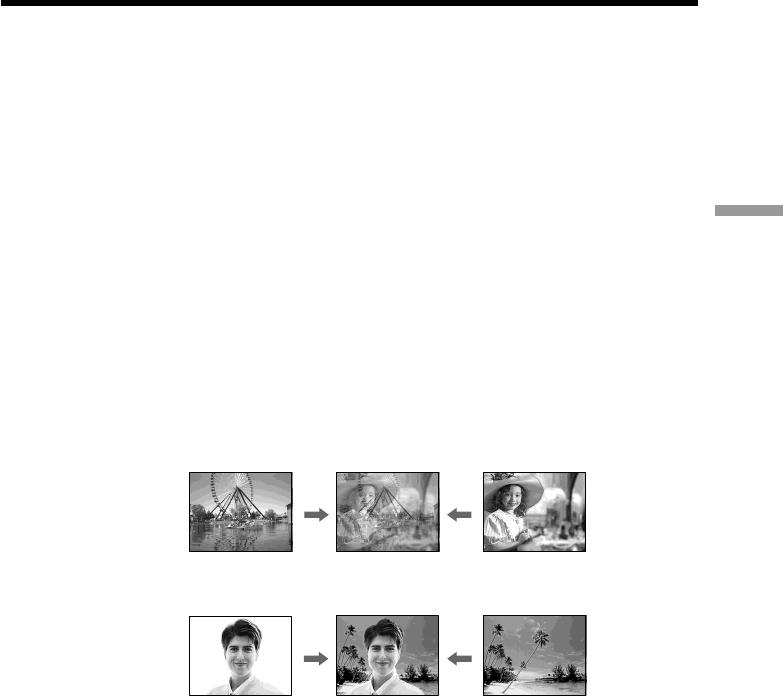
59
Advanced Recording Operations
Using special effects – Digital effect
You can add special effects to recorded pictures using the various digital functions.
Sound is recorded normally.
STILL
You can record a still image so that it is superimposed on a moving picture.
FLASH (FLASH MOTION)
You can record still images successively at constant intervals.
LUMI. (LUMINANCEKEY)
You can swap a brighter area in a still image with a moving picture.
TRAIL
You can record the picture so that an incidental image like a trail is left.
OLD MOVIE
You can add an old movie type atmosphere to pictures. Your camcorder automatically
sets the wide mode to ON and picture effect to SEPIA, and sets the appropriate shutter
speed.
STILL
LUMI.
Still image
Still image
Moving picture
Moving picture
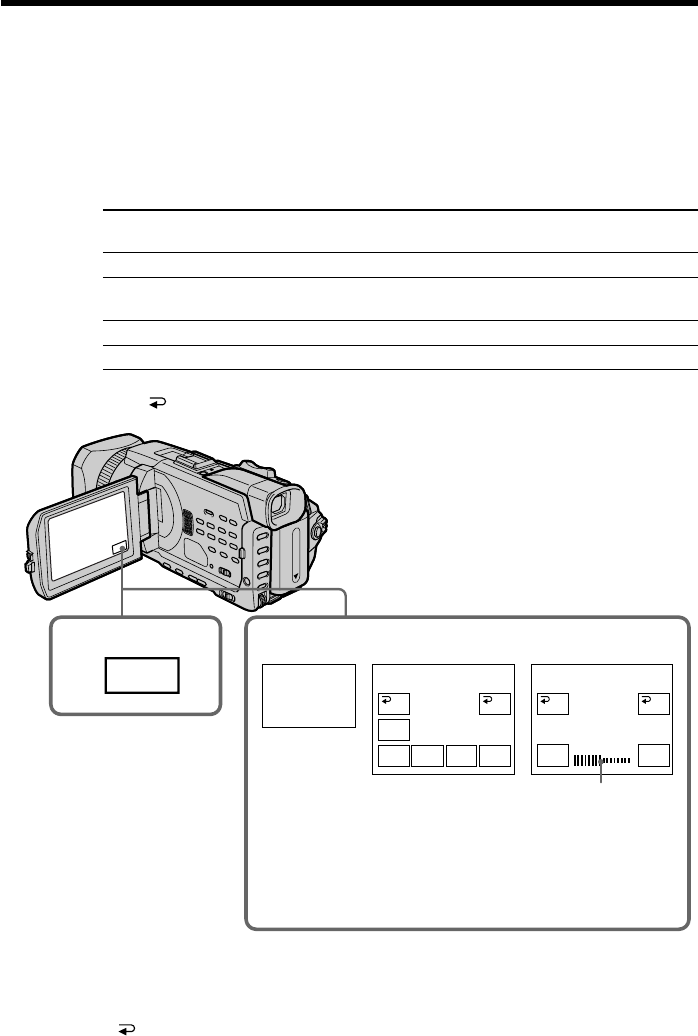
60
Using special effects – Digital effect
(1)Press FN to display PAGE1 while the POWER switch is set to CAMERA.
(2)Press DIG EFFT. The screen to select a desired digital effect appears.
(3)Press a desired mode. In the STILL and LUMI. modes, the still image is stored
in memory.
(4)Press –/+ to adjust the effect.
–:To reduce the effect
+: To increase the effect
Items to be adjusted
STILL The rate of the still image you want to superimpose on the moving
picture
FLASH The interval of frame by frame playback
LUMI. The color scheme of the area in the still image which is to be
swapped with a moving picture
TRAIL The vanishing time of the incidental image
OLD MOVIE No adjustment necessary
(5)Press OK to return to PAGE1.
To return to FN
Press EXIT.
To cancel the digital effect
Press OFF to return to PAGE1.
1 2~4
FN
LUMI.
–+
OK
OFF
DIG
EFFT
DIG EFFT DIG EFFT
STILL
OLD
MOVIE
OFF OK
LUMI.FLASH TRAIL
The bar appears when setting following
digital effects modes : STILL, FLASH,
LUMI., TRAIL.

61
Advanced Recording Operations
Using special effects – Digital effect
Notes
•The following functions do not work during digital effect:
–Recording still images on a “Memory Stick” in the tape recording or recording
standby
–Tape photo recording
–Fader
–Shutter speed (1/30 or smaller) adjustment
•The following functions do not work in the old movie:
–Wide mode
–Picture effect
–PROGRAM AE
–Shutter speed adjustment
When you set the POWER switch to OFF (CHG)
Digital effect is automatically canceled.
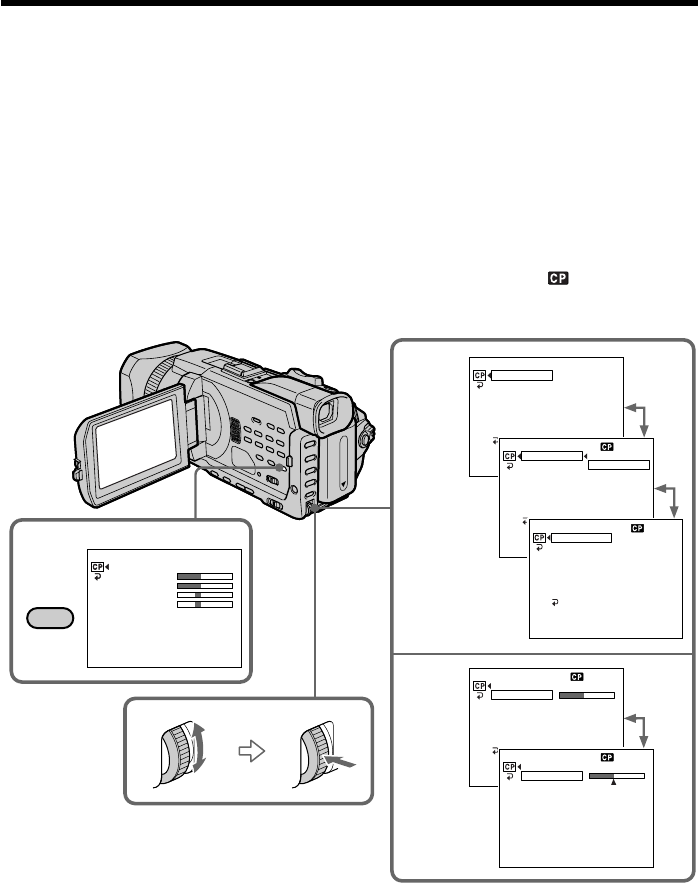
62
Presetting the adjustment for picture
quality – Custom preset
You can preset the camcorder to record the picture with the desired picture quality.
When presetting, adjust the picture by shooting a subject and checking the picture
displayed on a TV (p. 45).
(1)Press CUSTOM PRESET to display the CUSTOM PRESET menu while the
POWER switch is set to CAMERA or MEMORY/NETWORK (DCR-TRV950
only).
(2)Press the SEL/PUSH EXEC dial.
(3)Turn the SEL/PUSH EXEC dial to select SET, then press the dial.
(4)Turn the SEL/PUSH EXEC dial to select ON, then press the dial.
(5)Turn the SEL/PUSH EXEC dial to select the desired item, then press the dial.
(6)Turn the SEL/PUSH EXEC dial to adjust the selected item, then press the dial.
(7)Press CUSTOM PRESET.
The CUSTOM PRESET menu disappears and the indicator appears on the
screen.
2-4
5,6
1
CUSTOM PRESET
[CP] : END
CUSTOM PRESET STBY
[CP] : END
CUSTOM PRESET STBY
SET
COLOR LVL
SHARPNESS
WB SH
I
FT
AE SH
I
FT
AGC LIMIT
RESET
RETURN
OFF
[CP] : END
CUSTOM PRESET STBY
SET
COLOR LVL
SHARPNESS
WB SH
I
FT
AE SH
I
FT
AGC LIMIT
RESET
RETURN
OFF
ON
[CP] : END
CUSTOM PRESET STBY
SET
COLOR LVL
SHARPNESS
WB SH
I
FT
AE SH
I
FT
AGC LIMIT
RESET
RETURN
ON
[CP] : END
CUSTOM PRESET STBY
SET
COLOR LVL
SHARPNESS
WB SH
I
FT
AE SH
I
FT
AGC LIMIT
RESET
RETURN
[CP] : END
CUSTOM PRESET STBY
COLOR LVL
[CP] : END
SET
COLOR LVL
SHARPNESS
WB SH
I
FT
AE SH
I
FT
AGC LIMIT
RESET
OFF
OFF
CUSTOM
PRESET

63
Advanced Recording Operations
Presetting the adjustment for picture quality – Custom preset
Items to be adjusted
Item
COLOR LVL
SHARPNESS
WB SHIFT
AE SHIFT
AGC LIMIT
RESET
To cancel using the custom preset
Select OFF in step 4. The setting is still maintained at this moment. To return to the
standard setting, select RESET in step 6.
To check the custom preset setting
Press CUSTOM PRESET while the POWER switch is set to CAMERA or MEMORY/
NETWORK (DCR-TRV950 only).
The custom preset setting appears on the screen.
When you preset the desired picture quality in CAMERA or MEMORY/NETWORK
(DCR-TRV950 only)
The preset is only available in each mode you preset. If you want to use a preset both in
CAMERA and MEMORY/NETWORK (DCR-TRV950 only), you have to preset in each
mode.
About the AGC Limit
When adjusting the exposure manually, the level of the gain is up to 18 dB (OFF).
Adjustment value
Decreases color intensity y
Increases color intensity
Softer y Sharper
Bluish y Reddish
Dim y Brighten
6 dB/12 dB/OFF
Meaning
Color intensity
Sharpness
White balance
Brightness
Auto Gain-limit
Sets items above to the default
settings.
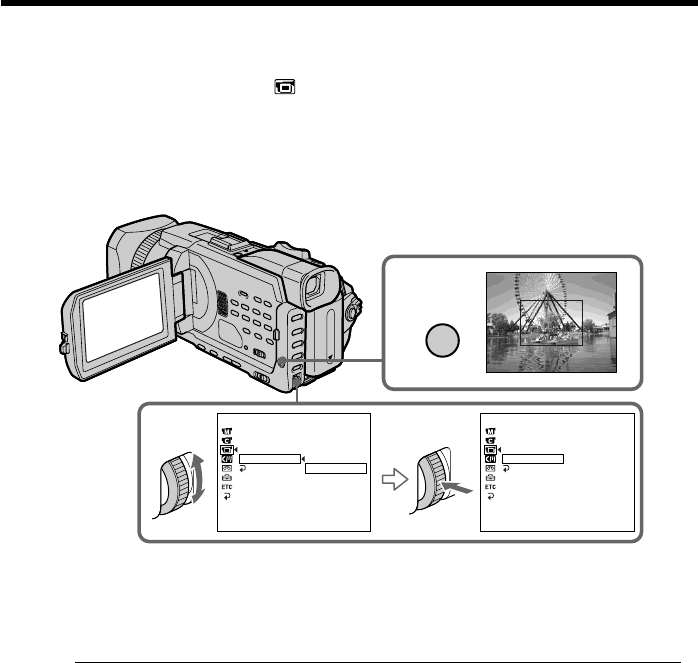
64
Using the guide frame
You can easily make the picture be on a horizontal line using the guide frame. The
guide frame is not recorded in the tape or the “Memory Stick.”
(1)Set GUIDE FRAME in to ON in the menu setting while the POWER
switch is set to CAMERA or MEMORY/NETWORK (DCR-TRV950 only).
(p210)
(2)Press MENU to erase the menu display. The guide frame is displayed on the
screen.
To clear the guide frame
Select GUIDE FRAME to OFF in the menu setting or simply press DISPLAY/TOUCH
PANEL.
Note
The guide frame indicates only a rough level. The size and position of the guide
frame do not affect the setting of the camcorder.
If you set GUIDEFRAME to ON
The other indicators are also displayed on the screen.
1
2
MENU
LCD/ VF SET
LCD B. L.
LCD COLOR
VF B. L.
GU I DEFRAME
RETURN
[MENU] : END
OFF
ON
LCD/ VF SET
LCD B. L.
LCD COLOR
VF B. L.
GU I DEFRAME
RETURN
[MENU] : END
ON